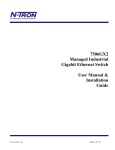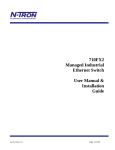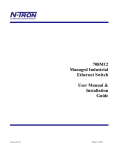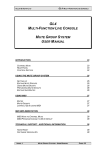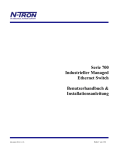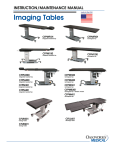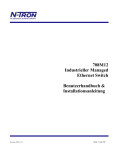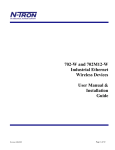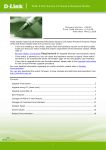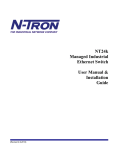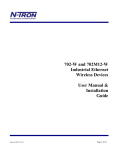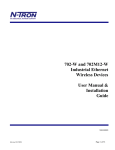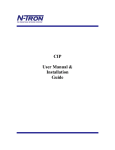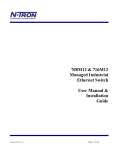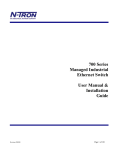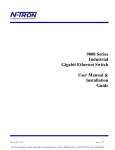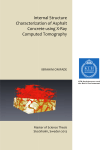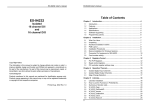Download 7018 Series Managed Industrial Ethernet Switch User Manual
Transcript
7018 Series Managed Industrial Ethernet Switch User Manual & Installation Guide (Revised 8/3/2009) Page 1 of 138 7018TX, 7018FX2, and 7018FXE2 Industrial Ethernet Switch Installation Guide..................................................... 4 SAFETY WARNINGS ................................................................................................................................................ 6 Installation .................................................................................................................................................................... 7 Connecting the Unit ................................................................................................................................................... 12 Overview of Advanced Features ................................................................................................................................ 16 Mode of Operation .................................................................................................................................................................. 16 Port Mirroring ......................................................................................................................................................................... 16 Port Trunking .......................................................................................................................................................................... 16 Priority Tagging (QoS)............................................................................................................................................................ 16 Virtual LAN ............................................................................................................................................................................ 17 Rapid Spanning Tree Protocol ................................................................................................................................................ 17 SNMP Traps ............................................................................................................................................................................ 17 IGMP Snooping ...................................................................................................................................................................... 17 N-Ring ..................................................................................................................................................................................... 18 N-Link ..................................................................................................................................................................................... 18 DHCP ...................................................................................................................................................................................... 19 DHCP Client ........................................................................................................................................................................... 19 DHCP Relay Agent ................................................................................................................................................................. 19 DHCP Server ........................................................................................................................................................................... 19 Web Software Configuration ..................................................................................................................................... 21 Web Management ................................................................................................................................................................... 21 Web Management - Home ...................................................................................................................................................... 22 Administration – System ......................................................................................................................................................... 24 Administration – SNMP .......................................................................................................................................................... 26 Administration – Fault ............................................................................................................................................................ 28 DHCP – Server – Setup Profiles ............................................................................................................................................. 29 DHCP – Server – Setup IP Maps ............................................................................................................................................ 31 DHCP – Server – View Bindings ............................................................................................................................................ 36 DHCP – Relay & Local IP - Setup .......................................................................................................................................... 37 Ports – Configuration .............................................................................................................................................................. 40 Ports – Mirroring ..................................................................................................................................................................... 43 Ports – Trunking ...................................................................................................................................................................... 45 Statistics – Port Statistics ........................................................................................................................................................ 46 Statistics – Port Utilization ...................................................................................................................................................... 47 VLAN – Configuration ........................................................................................................................................................... 48 Bridging – Aging Time ........................................................................................................................................................... 50 Bridging – Unicast Addresses ................................................................................................................................................. 51 Bridging – Multicast Addresses .............................................................................................................................................. 53 Bridging – Show MAC by Port ............................................................................................................................................... 55 RSTP – Configuration ............................................................................................................................................................. 57 IGMP – Configuration ............................................................................................................................................................ 61 IGMP – Show Group and Show Router .................................................................................................................................. 64 IGMP – RFilter ....................................................................................................................................................................... 65 N-View – Configuration.......................................................................................................................................................... 67 N-View – Ports ........................................................................................................................................................................ 68 N-Ring – Configuration .......................................................................................................................................................... 70 N-Ring – Advanced Configuration ......................................................................................................................................... 73 N-Ring – Status ....................................................................................................................................................................... 75 N-Link – Configuration ........................................................................................................................................................... 79 N-Link – Status ....................................................................................................................................................................... 83 Firmware/Config – TFTP ........................................................................................................................................................ 88 Support – Web Site and E-mail ............................................................................................................................................... 90 BPCL – Broadcast Packet Count Limit Configuration ........................................................................................................... 91 User Management – Adding Users ......................................................................................................................................... 93 User Management – Removing Users ..................................................................................................................................... 94 LogicalView ............................................................................................................................................................................ 95 Configuration – Save or Reset................................................................................................................................................. 96 Help ......................................................................................................................................................................................... 97 Help – Administration ............................................................................................................................................................. 98 (Revised 8/3/2009) Page 2 of 138 Help – DHCP .......................................................................................................................................................................... 99 Help – Ports ........................................................................................................................................................................... 100 Help – Statistics..................................................................................................................................................................... 101 Help – VLAN ........................................................................................................................................................................ 102 Help – BPCL ......................................................................................................................................................................... 103 Help – IGMP ......................................................................................................................................................................... 104 Help – Bridging ..................................................................................................................................................................... 105 Help – RSTP ......................................................................................................................................................................... 106 Help – Firmware/Config ....................................................................................................................................................... 107 Help – User Management ...................................................................................................................................................... 108 Help – N-View ...................................................................................................................................................................... 109 Help – N-Ring ....................................................................................................................................................................... 110 Help – N-Link ....................................................................................................................................................................... 111 Help – Other .......................................................................................................................................................................... 112 CLI Commands ........................................................................................................................................................ 113 “?” (Help) .............................................................................................................................................................................. 113 Logout ................................................................................................................................................................................... 113 Show, Add, or Delete ARL Entries ....................................................................................................................................... 114 Save or Reset the Configuration Settings .............................................................................................................................. 115 Show or Set IGMP Configuration ......................................................................................................................................... 115 Show or Set Mirror Configuration ........................................................................................................................................ 116 Show or Set N-Ring Configuration ....................................................................................................................................... 117 Show or Set N-View Configuration ...................................................................................................................................... 117 Ping a Host ............................................................................................................................................................................ 118 Show or Set Port Configuration ............................................................................................................................................ 119 Reset the Switch .................................................................................................................................................................... 119 Show or Set SNMP Configuration ........................................................................................................................................ 120 Show or Clear the Last System Error .................................................................................................................................... 120 Show System Information ..................................................................................................................................................... 121 Set or Show the System IP Configuration ............................................................................................................................. 122 Show or Set System Configuration ....................................................................................................................................... 123 VLAN Addition and Deletion Example ................................................................................................................... 124 VLAN Configuration Examples .............................................................................................................................. 130 Example 1 – Basic understanding of port-based VLANs ...................................................................................................... 130 Example 2 – Basic understanding of tagged VLANs (Admit – Tagged Only) ..................................................................... 131 Example 3 – Basic understanding of tagged VLANs (Admit – All) ..................................................................................... 132 Example 4 – Basic understanding of Hybrid VLANs ........................................................................................................... 133 Example 5 – Basic understanding of Overlapping VLANs................................................................................................... 134 Example 6 – Basic understanding of VLANs with Multicast Filtering ................................................................................. 135 KEY SPECIFICATION ........................................................................................................................................... 136 N-TRON Limited Warranty ..................................................................................................................................... 138 (Revised 8/3/2009) Page 3 of 138 7018TX, 7018FX2, and 7018FXE2 Industrial Ethernet Switch Installation Guide The N-TRON 7018 Series Industrial Ethernet Switch offers outstanding performance and ease of use. It is ideally suited for connecting Ethernet enabled industrial and or security equipment and is a fully managed switch. PRODUCT FEATURES PRODUCT CONFIGURATIONS • Full IEEE 802.3 Compliance • Fourteen 10/100 BaseTX RJ-45 Ports • Sixteen 10/100 BaseTX RJ-45 Ports (7018TX model only) • Two Optional Gigabit ports: o 1000BaseSX/LX Ports, LC style, and/or o 1000BaseT Ports, RJ45 style • Two Optional 100BaseFX(E) Ports (7018FX2 and 7018FXE2 models only) • Extended Environmental Specifications • Auto Sensing 10/100BaseTX, Duplex, and MDIX • Offers Rapid Spanning Tree Protocol • Trunk with other N-Tron trunking capable switches over two ports • Store & Forward Technology • Plug and Play IGMP Support • Rugged Din-Rail Enclosure • Redundant Power Inputs (10-30 VDC) o –HV High Voltage Option (40-160VDC) • SNMP v1, v2 and v3. • Web Browser Management with detailed ring map and fault location charting. • Web Browsing and N-View Switch Monitoring • 7018TX-VV – Sixteen 10/100 Base-TX RJ45 Copper Ports, and two optional SFP transceivers • 7018FX2-XX-VV – Fourteen 10/100 Base-TX RJ45 Copper Ports, two multimode 100BaseFX Ports, and two optional SFP transceivers • 7018FXE2-XX-YY-VV – Fourteen 10/100 Base-TX RJ45 Copper Ports, two singlemode 100BaseFX Ports and two optional SFP transceivers (Revised 8/3/2009) Where: XX = ST or SC YY = 10, 40 or 80 for Singlemode, Blank for Multimode E = Singlemode, Blank Otherwise VV = HV for High voltage, Blank for Standard voltage MANAGEMENT FEATURES • IGMP Snooping • VLAN • QoS • Port Trunking • Port Mirroring • 802.1D-2004 Rapid Spanning Tree • N-RING™ (N-Tron proprietary Ring Management) • N-LINK™ (N-Tron proprietary Coupling Management) • DHCP Server, Option 82 relay Page 4 of 138 Copyright, © N-Tron Corp., 2008-2009 820 S. University Blvd., Suite 4E Mobile, AL 36609 USA All rights reserved. Reproduction, adaptation, or translation without prior written permission from N-Tron Corp. is prohibited, except as allowed under copyright laws. Ethernet is a registered trademark of Xerox Corporation. All other product names, company names, logos or other designations mentioned herein are trademarks of their respective owners. The information contained in this document is subject to change without notice. N-Tron Corp. makes no warranty of any kind with regard to this material, including, but not limited to, the implied warranties of merchantability or fitness for a particular purpose. In no event shall N-Tron Corp. be liable for any incidental, special, indirect, or consequential damages whatsoever included but not limited to lost profits arising out of errors or omissions in this manual or the information contained herein. Warning Do not perform any services on the unit unless qualified to do so. Do not substitute unauthorized parts or make unauthorized modifications to the unit. Do not operate the unit with the top cover removed, as this could create a shock or fire hazard. Do not block the air vents on the sides or the top of the unit. Do not operate the equipment in the presence of flammable gasses or fumes. Operating electrical equipment in such an environment constitutes a definite safety hazard. Do not operate the equipment in a manner not specified by this manual. (Revised 8/3/2009) Page 5 of 138 SAFETY WARNINGS GENERAL SAFETY WARNINGS WARNING: If the equipment is used in the manner not specified by N-Tron Corp., the protection provided by the equipment may be impaired. LASER SAFETY (7018FXE2 Models -40, -80 and optional NTSFP-LX -40 and -70) CAUTION: CLASS 1 LASER PRODUCT. Do not stare into the laser! Contact Information N-Tron Corp. 820 South University Blvd. Suite 4E Mobile, AL 36609 TEL: (251) 342-2164 FAX: (251) 342-6353 WEBSITE: www.n-tron.com E-MAIL: [email protected] ENVIRONMENTAL SAFETY WARNING: Disconnect the power and allow to cool 5 minutes before touching. ELECTRICAL SAFETY Must be used with Listed UL Industrial Power Supply. WARNING: Disconnect the power cable before removing the top cover. WARNING: Do not operate the unit with the any cover removed. WARNING: Do not work on equipment or cables during periods of lightning activity. WARNING: Do not perform any services on the unit unless qualified to do so. WARNING: Do not block the air vents. WARNING: Observe proper DC Voltage polarity when installing power input cables. Reversing voltage polarity can cause permanent damage to the unit and void the warranty. (Revised 8/3/2009) Page 6 of 138 Hazardous Location Installation Requirements 1. This equipment is suitable for use in Class I, Div. 2, Groups A, B, C, D or non-hazardous locations only. 2. WARNING: Explosion Hazard – Substitution of components may impair suitability for Class I, Div. 2. 3. WARNING: Explosion Hazard - do not disconnect while circuit is live, unless area is known to be non-hazardous. 4. WARNING: Explosion Hazard – do not replace the device unless power has been switched off or the area is known to be non-hazardous. 5. Use 90°C or higher rated Copper wire, (0.22Nm) 2lb/in Tightening torque for field installed conductors. Please make sure the 7018 Series Ethernet Switch package contains the following items: 1. 7018 Series Switch 2. Product CD Contact your carrier if any items are damaged. Installation Read the following warning before beginning the installation: WARNING Never install or work on electrical equipment or cabling during periods of lightning activity. Never connect or disconnect power when hazardous gasses are present. Disconnect the power cable before removing any enclosure panel. UNPACKING Remove all the equipment from the packaging, and store the packaging in a safe place. File any damage claims with the carrier. CLEANING Clean only with a damp cloth. (Revised 8/3/2009) Page 7 of 138 DIN RAIL MOUNTING Install the unit on a standard 35mm Din-Rail. Recess the 7018TX unit to allow at least 3” of horizontal clearance for copper cable bend radius. Recess the 7018FX2 unit to allow at least 5” of horizontal clearance for fiber cable bend radius. There should be at least 4” of clearance on both the top and bottom of the unit to allow proper ventilation. To mount the unit to the 35mm din-rail, place top edge of the bracket on the back of the unit against the din-rail at an upward angle. Lower the bottom of the unit until it snaps into place. To remove the unit from the 35mm din-rail, place a flat head screwdriver into the release clip at the bottom of the unit, and push down on the clip until it disengages from the bottom of the unit from the din-rail. Lift the bottom of the unit up at an approximate 45° upward Note: When mounting the switch in the vertical angle to completely remove the unit. position, you must orientate the power connector to the top as shown above for proper ventilation. (Revised 8/3/2009) Page 8 of 138 Most N-Tron™ products are designed to be mounted on industry standard 35mm DIN-Rail. However, DIN-Rail mounting may not be suitable for all applications. Our Universal Rack Mount Kit (P/N: URMK) may be used to mount the 7018 Series to standard 19" racks as an option. (Revised 8/3/2009) Page 9 of 138 FRONT PANEL From Top to Left: Gigabit Ports RJ45 Ports Fiber Ports 1000 Base SFP Copper or Fiber Transceivers (Optional) Auto Sensing 10/100 Base-TX Connections 100 Base-FX Connections (only on 7018FX2 model) LED lights when Power is supplied to the unit NOTE: The RJ45 data port has two LEDs located on each connector. The left LED indicates LINK status, and the right LED indicates ACTIVITY. LEDs: The table below describes the operating modes: LED Color Description GREEN Power is ON RED Power is ON and a fault condition exists OFF Power is OFF GREEN 10/100/1000Mb Link between ports OFF No Link between ports GREEN Data is active between ports OFF Data is inactive between ports LNK ACT (Revised 8/3/2009) Page 10 of 138 APPLYING POWER (Side View) • Unscrew & Remove the DC Voltage Input Plug from the Power Input Header • Install the DC Power Cables into the Plug (observing polarity). • Plug the Voltage Input Plug back into the Power Input Header. • Tightening torque for the terminal block power plug is 0.5 Nm/0.368 Pound Foot. • Verify the Power LED stays ON (GREEN). Notes: • Only 1 power supply must be connected to power for minimal operation. For redundant power operation, V1 and V2 inputs must be connected to separate DC Voltage sources. This device will draw current from both sources simultaneously. Use 16-28 gauge wire when connecting to the power supply. • The Fault pins on the power connector can be used for an alarm contact. The current carrying capacity is 1A at 24VDC. It is normally open and the relay closes when a fault condition occurs. These pins can be used to connect an external warning device such as a light in order to provide an external alarm. The conditions for generating a fault condition (closing the relay) can be configured through software. Recommended 24V DC Power Supplies, similar to: N-Tron’s P/N NTPS-24-1.3 (NOTE: Not appropriate for use with M12, POE, and HV models.): • Input AC 115/230V • Power 72W • Output DC 24-28V • 35 mm DIN-Rail Mountable • Output Current 1.3A @ 24V • Dimensions: 45X75X91 mm 1.0A @ 28V (Revised 8/3/2009) Page 11 of 138 Connecting the Unit For FX/FXE units, remove the dust cap from the fiber optic connectors and connect the fiber optic cables. The TX port on the FX/FXE models should be connected to the RX port of the far end station. The RX port on the FX/FXE versions should be connected to the TX port of the far end station. For 10/100 Base-TX ports, plug a Category 5E twisted pair cable into the RJ45 connector. Connect the other end to the far end station. Verify that the LNK LEDs are ON once the connection has been completed. To connect any port to another device (end node, Switch or Repeater), use a standard Category 5E straight through or crossover cable with a minimum length of one meter and a maximum length of 100 meters. N-Tron recommends the use of premanufactured Cat5E cables to ensure the best performance. If this is not an option and users must terminate their own ends on the Cat5E cables; one of the two color coded standards shown to the right should be utilized. If a user does not follow one of these two color code standards then the performance and maximum cable distance will be reduced significantly, and may prevent the switch from establishing a link. Warning: Creating a port to port connection on the same switch (i.e. loop) is an illegal operation and will create a broadcast storm which will crash the network! (Revised 8/3/2009) Page 12 of 138 N-TRON SWITCH GROUNDING TECHNIQUES The grounding philosophy of any control system is an integral part of the design. N-Tron switches are designed to be grounded, but the user has been given the flexibility to float the switch when required. The best noise immunity and emissions (i.e. CE) are obtained when the N-Tron switch chassis is connected to earth ground via a drain wire. Some N-Tron switches have metal din-rail brackets that can ground the switch if the din-rail is grounded. In some cases, N-Tron switches with metal brackets can be supplied with optional plastic brackets if isolation is required. Both V- legs of the power input connector are connected to chassis internally on the PCB. Connecting a drain wire to earth ground from one of the V- terminal plugs as shown here will ground the switch and the chassis. The power leads from the power source should be limited to 3 meters or less in length. As an alternate, users can run a drain wire & lug from any of the Din-Rail screws or empty PEM nuts on the enclosure. When using an unused PEM nut to connect a ground lug via a machine screw, care should be taken to limit the penetration of the outer skin by less than 1/4 in. Failure to do so may cause irreversible damage to the internal components of the switch. Note: Before applying power to the grounded switch, you must use a volt meter to verify there is no voltage difference between the power supply’s negative output terminal and the switch chassis grounding point. If the use of shielded cables is required, it is generally recommended to only connect the shield at one end to prevent ground loops and interfere with low level signals (i.e. thermocouples, RTD, etc.). Cat5e cables manufactured to EIA-568A or 568B specifications are required for use with N-Tron Switches. In the event all Cat5e patch cable distances are small (i.e. All Ethernet devices are located in the same local cabinet and/or referenced to the same earth ground), it is permissible to use fully shielded cables terminated to chassis ground at both ends in systems void of low level analog signals. (Revised 8/3/2009) Page 13 of 138 RJ45 CONNECTOR CRIMP SPECIFICATIONS Please reference the illustration below for your Cat5 cable specifications: (Revised 8/3/2009) Page 14 of 138 SERIAL INTERFACE The 7018 Series switches provide an EIA-232 interface accessed via a 9-pin female connector (labeled ‘COM’ on the unit). This is used to access the Command Line Interpreter (CLI). The pin-outs are shown below: Serial Cable Connect the serial COM port of your PC and the 7018 Series Switch using a standard straight through serial cable. You will require a cable with a 9-pin or 25-pin sub-D female connector for the PC end, and a 9-pin male sub-D connector for the 7018 Series end. The following table shows the pin-out and the connections for both types of cable: PC Port Signal Name TXD RXD GND 25-Pin Female Pin # 2 3 7 9-Pin Female Pin # 3 2 5 7018 series 9-Pin Male Pin # Signal Name 3 RXD 2 TXD 5 GND Standard straight through serial cables are readily available from a variety of computer stores. HyperTerminal The following configuration should be used in HyperTerminal: Port Settings: Data Bits: Parity: Stop bits: Flow Control: (Revised 8/3/2009) 115200 8 NONE 1 NONE Page 15 of 138 Overview of Advanced Features Mode of Operation Each port on the switch can be configured into different modes of operation as shown below: Copper Ports: - Half Duplex - Full Duplex - Auto Negotiation 100Base Fiber Ports: - Full Duplex 1000Base Copper/Fiber Ports: - Full Duplex Half Duplex In half duplex mode, the CSMA/CD media access method is the means by which two or more stations share a common transmission medium. To transmit, a station waits (defers) for a quiet period on the medium (that is, no other station is transmitting) and then sends the intended message in bit-serial form. If, after initiating a transmission, the message collides with that of another station, then each transmitting station intentionally transmits for an additional predefined period to ensure propagation of the collision throughout the system. The station remains silent for a random amount of time (back-off) before attempting to transmit again. Full Duplex Full duplex operation allows simultaneous communication between a pair of stations using point-to-point media (dedicated channel). Full duplex operation does not require that transmitters defer, nor do they monitor or react to receive activity, as there is no contention for a shared medium in this mode. Auto Negotiation In Auto Negotiation mode, the port / hardware detects the mode of operation of the station that is connected to this port and sets its mode to match the mode of the station. Port Mirroring A Mirroring Port is a dedicated port that is configured to receive the copies of Ethernet frames that are being transmitted out and also being received in from any other port that is being monitored. Port Trunking Port Trunking is the ability to group two network ports to increase the bandwidth between two machines (switch or any work station). This feature allows grouping of high-speed connectivity and provides redundant connection between switches, so that a trunk can act as a single link between the switches. Priority Tagging (QoS) IEEE 802.1p priority tagging is supported for two classes of services along with bandwidth support per priority level. Transparent mode is supported through configuration wherein if the field is set, the tag bits are ignored. The user can configure up to 8 different priority levels per port. Also priority overriding (overriding the tagged field) can be enabled or disabled by the user. (Revised 8/3/2009) Page 16 of 138 Virtual LAN The switch provides support for setting up tagged Virtual LANs. A port may belong to any number of Virtual LANs. The VLAN membership of a station is determined by the VLAN(s) that have been defined for the port to which the station is connected. If a station should move from one port to another, it loses its current VLAN membership and inherits that of the new port it is connected to. A Default Virtual LAN exists to which a port, which is not a member of any other Virtual LAN, will belong. This allows the switch to operate as a ‘normal’ Bridge when it is used in a network. A port is automatically removed from the Default VLAN when it is reconfigured to belong to another Virtual LAN. Using Tagged VLANs, the switch has the ability to take non-tagged packets in some ports, add a VLAN tag to the packet and send it out tagged ports on the switch. The VLANs can also be configured to accept tagged packets in tagged ports, strip the tags off the packets, and send the packets back out other untagged ports. This allows a network administrator to set up the switch so he can support devices on the network that do not support VLAN Tagged packets. The administrator can also set up the ports to discard any packets that are tagged or to discard any packets that are untagged based on a hybrid VLAN of both tagged and untagged ports, and using the VLAN Ingress Filter on the switch. The 7018 Series switch also has the ability to allow overlapping VLANs. Overlapping VLANs give the user the ability to have one or more ports share two or more VLAN groups. For more information and examples on how this could be implemented, please see our website’s technical documents. Rapid Spanning Tree Protocol The Rapid Spanning Tree Protocol as specified in IEEE 802.1D-2004 is supported. One Spanning Tree per non-overlapping VLAN is supported. The Rapid Spanning Tree Protocol (RSTP) supersedes the Spanning Tree Protocol (STP) which was described in IEEE 802.1D-1998. The RSTP is used to configure a simply connected active network topology from the arbitrarily connected bridges of a bridged network. Bridges effectively connect just the LANs to which their forwarding ports are attached. Ports that are in a blocking state do not forward frames. The bridges in the network exchange sufficient information to automatically derive a spanning tree. RSTP allows for much quicker learning of network topology changes than the older STP. RSTP supports new and improved features such as rapid transition to forwarding state. RSTP also sends out new BPDUs every hello time instead of just relaying them. RSTP interoperates with older STP switches by falling back to the older STP when the older BPDUs are detected on bridge ports. The user can also manually configure bridge ports to use the older STP when desired. SNMP Traps The 7018 Series switch supports up to 5 SNMP Trap Stations to which SNMP Traps will be sent. The switch supports five standard traps; Link Up, Link Down, Cold Start, Warm Start and Authentication Errors. SNMP Traps will be sent to all the trap stations configured on the switch when the corresponding trap is enabled. IGMP Snooping IGMP Snooping is enabled by default, and the switch is Plug and Play for IGMP. IGMP snooping provides intelligent network support for multicast applications. In particular, unneeded traffic is reduced. IGMP (Revised 8/3/2009) Page 17 of 138 Snooping is configured via the web console and if enabled, operates dynamically upon each power up. Also, there can be manual only or manual and dynamic operation. Note that “static multicast group address” can be used whether IGMP Snooping is enabled or not. IGMP Snooping will function dynamically without user intervention. If some of the devices in the LAN do not understand IGMP, then manual settings are provided to accommodate them. The Internet Group Management Protocol (IGMP) is a protocol that provides a way for a computer to report its multicast group membership to adjacent ‘routers’. In this case N-Tron 7018 series switches provide router-like functionality. Multicasting allows one computer to send content to multiple other computers that have identified themselves as interested in receiving the originating computer's content. Multicasting can be used to transmit only to an audience that has joined (and not left) a multicast group membership. IGMP version 2 is formally described in the Internet Engineering Task Force (IETF) Request for Comments (RFC) 2236. IGMP version 1 is formally described in the Internet Engineering Task Force (IETF) Request for Comments (RFC) 1112. The 7018 series supports v1 and v2. N-Ring N-Ring is enabled by default, and the switch is Plug and Play for N-Ring except that initially one must enable an N-Ring enabled device to be the N-Ring Manager for a given N-Ring. Subsequently, N-Ring operates dynamically upon each power up. Using N-Tron's proprietary N-Ring technology offers expanded ring size capacity, detailed fault diagnostics, and a standard healing time of 30ms. The N-Ring Manager periodically checks the health of the N-Ring via health check packets. If the N-Ring Manager stops receiving the health check packets, it times out and converts the N-Ring to a backbone within 30ms. When using all N-Ring enabled switches in the ring, a detailed ring map and fault location chart is also provided on the N-Ring Manager’s web browser. N-Ring status is also sent from the N-Ring Manager to the N-View OPC Server to identify the health status of the ring. Up to 250 N-Ring enabled switches can participate in one N-Ring topology. Switches that do not have N-Ring capability may be used in an N-Ring, however the ring map and fault location chart cannot be as detailed at these locations. N-Link The purpose of N-Link is to provide a way to redundantly couple an N-Ring topology to one or more other topologies, usually other N-Ring topologies. Each N-Link configuration requires 4 switches: N-Link Master, N-Link Slave, N-Link Primary Coupler, and N-Link Standby Coupler. N-Link will monitor the link status of the Primary and Standby Coupler links. While the Primary Coupler link is healthy, it will forward network traffic and the Standby Coupler link will block network traffic. When a problem is detected on the Primary Coupler link, the Primary Coupler link will block network traffic and the Standby Coupler link will forward network traffic. While the N-Link Master and Slave are in communication via the Control link, only one Coupler link (Primary or Standby) will forward network traffic while the other Coupler link will block network traffic. (Revised 8/3/2009) Page 18 of 138 DHCP For a DHCP overview, reference: http://www.n-tron.com/pdf/DHCP_White_Paper.pdf For detailed Engineering Instructions on DHCP, reference: http://www.n-tron.com/pdf/DHCP_Technical_Instructions.pdf DHCP Client The switch will automatically obtain an IP assignment from a DHCP Server. Communication between the client and server can optionally go through a DHCP Relay Agent. DHCP Relay Agent DHCP Relay Agent (Option 82) allows communication between the client and server to cross subnet and VLAN boundries. It also allows for a device on a specific port to receive a specific IP address and if the device is replaced, the replacement receives the same IP address as the original device. DHCP Server DHCP Server allows DHCP Client devices to automatically obtain an IP assignment. IP assignments can be set up as a dynamic range of IP addresses available to any client device; or specific IP addresses based on the clients MAC address, Client ID (Option 61), or Relay Agent connection (Option 82). (Revised 8/3/2009) Page 19 of 138 TROUBLESHOOTING (Power LED) is ON. 1. Make sure the 2. Make sure you are supplying sufficient current for the version chosen. Note: The Inrush current will exceed the steady state current by ~ 2X. 3. Verify that Link LEDs are ON for connected ports. 4. Verify cabling used between stations. 5. Verify that cabling is Category 5E or greater for 100Mbit operation. SUPPORT Contact N-Tron Corp. at: TEL: 251-342-2164 FAX: 251-342-6353 E-MAIL: [email protected] WEB: www.n-tron.com FCC STATEMENT This product complies with Part 15 of the FCC-A Rules. Operation is subject to the following conditions: (1) This device may not cause harmful Interference (2) This device must accept any interference received, including interference that may cause undesired operation. NOTE: This equipment has been tested and found to comply with the limits for a Class A digital device, pursuant to Part 15 of the FCC Rules. These limits are designed to provide reasonable protection against harmful interference in a residential installation. This equipment generates, uses, and can radiate radio frequency energy and, if not installed and used in accordance with the instructions, may cause harmful interference to radio communications. Operation of this device in a residential area is likely to cause harmful interference in which case the user will be required to correct the interference at his/her own expense. INDUSTRY CANADA This Class A digital apparatus meets all requirements of the Canadian Interference Causing Equipment Regulations. Operation is subject to the following two conditions; (1) this device digital apparatus meets all requirements of the Canadian Interference Causing Equipment Regulations. Operation is subject to the following two conditions; (1) this device may not cause harmful interference, and (2) this device must accept any interference received, including interference that may cause undesired operation. Cet appareillage numérique de la classe A répond à toutes les exigences de l'interférence canadienne causant des règlements d'équipement. L'opération est sujette aux deux conditions suivantes: (1) ce dispositif peut ne pas causer l'interférence nocive, et (2) ce dispositif doit accepter n'importe quelle interférence reçue, y compris l'interférence qui peut causer l'opération peu désirée. (Revised 8/3/2009) Page 20 of 138 Web Software Configuration Web Management Enter the switch’s IP address in any web browser and login to the web management feature of the 7018 Series. Default: User Name: admin Password: admin (Revised 8/3/2009) Page 21 of 138 Web Management - Home When the administrator first logs onto a 7018 Series switch the default home page will be displayed. On the left hand side of the screen there is a list of configurable settings that the 7018 Series switch will support. This section of the manual will go through each and every choice listed on the left hand side of the screen and explain how to configure those settings. In the center of the main home page the administrator can see some basic information like what firmware revision the switch is running. The firmware can be upgraded at a later time in the field using TFTP. (Revised 8/3/2009) Page 22 of 138 Web Management – Menu Structure To the left, there is a menu which is shown fully opened below. The pages opened by each of the individual selections are described in the rest of this section. The use of each of these pages is also described in this section. In most of the descriptions, only the right side of the page is shown. (Revised 8/3/2009) Page 23 of 138 Administration – System The System tab under the Administration category lists the following information about the switch: IP Address Contains the configured IP Address of the device. Subnet Mask Contains the configured Subnet Mask of the device. Gateway Contains the configured Default Gateway of the device. MAC Address MAC Address of the device. System Up Time This parameter represents the total time count. This time has elapsed since the switch was turned ON or RESET. Name It shows the name of the product, which allows alphanumeric and special characters (#, _, -) only. Contact The person to contact for system issues, which should be someone within your organization. Location The physical location of the switch. (Revised 8/3/2009) Page 24 of 138 Administration – System, Continued… By selecting the Modify button, you will be able to change the switch’s IP Address, Subnet Mask, Gateway, Name, Contact information, and the Location of the switch through the web management features. It is recommended to change the TCP/IP information through the Command Line Interface (CLI) initially, but it defaults to the following: IP Address – 192.168.1.201 Subnet Mask – 255.255.255.0 Gateway – 192.168.1.1 (Revised 8/3/2009) Page 25 of 138 Administration – SNMP The SNMP tab under the Administration category shows a list of IP Addresses that act as SNMP Traps. The Read-Only, Read-Write, and Trap Community Names are also shown here. By selecting the Modify button, you will be able to change any of the fields listed. This allows the user to set an IP address for a Trap station or change the Community Names. If the SNMP Notification Trap is enabled, systems that are listed as a Trap station will be sent the corresponding notification trap. To restore a Trap to “Value Not Configured”, enter ‘0.0.0.0’. (Revised 8/3/2009) Page 26 of 138 Administration – SNMP, Continued… (Revised 8/3/2009) Page 27 of 138 Administration – Fault The Fault tab under the Administration category provides configurable selections indicating the way to notify when a Power, N-Link or N-Ring Signal fault occurs. Power signal faults consist of V1 and V2. NLink Faults can also be set for notification. The Power and N-Link notifications may consist of any combination of the options: Show Web, Show LED, and Contact. N-Ring signal faults consist of: Broken, Partial Break (Low), Partial Break (High), and Multiple Managers. (Revised 8/3/2009) Page 28 of 138 DHCP – Server – Setup Profiles The Setup Profiles tab under the DHCP/Server category lists the following information about the current state of the server and the existing network profiles: Server Enabled Indicates whether the DHCP server is active. Allow Broadcast Indicates whether the DHCP server will process broadcast messages. Delay Broadcast (Ms) The amount of time the DHCP server will delay processing a broadcast message. Server ID Descriptive name of the DHCP server. Profile Name Descriptive name of the network profile. Address Pool Range of IP addresses which the profile can use. Subnet Address The most restrictive subnet address calculated from the address pool range. Subnet Mask The most restrictive subnet mask calculated from the address pool range. Domain Name The domain name to be presented to the client. Has Profile IP Maps Indicates whether the profile has IP maps associated with it. Delete Deletes the profile along with all IP maps and bindings associated with it. The Default profile cannot be deleted. (Revised 8/3/2009) Page 29 of 138 DHCP – Server – Setup Profiles, Continued… (Revised 8/3/2009) Page 30 of 138 DHCP – Server – Setup IP Maps The Setup IP Maps tab provides the way to create IP mappings with an existing network profile. There are three types of mappings that can be created: Dynamic Range, Static Range, and Single IP. The Dynamic Range type of mapping is used to create a range of dynamic IP addresses for requesting clients. The following information is required: Network Profile An existing network profile to which the IP map applies. Low IP The starting IP address of a range. High IP The ending IP address of a range. The Static Range type of mapping is used to create a range of static IP addresses dedicated to specific ports on a relay agent switch. There are two different data entry formats available according to whether the relay agent type is for an N-TRON or for a generic switch. To create a range of static IP addresses on an N-Tron relay agent switch: Network Profile An existing network profile to which the IP map applies. (Revised 8/3/2009) Page 31 of 138 DHCP – Server – Setup IP Maps, Continued… Relay Agent Type Should be set to N-TRON. Switch Model List of N-TRON models that support this feature. Remote ID A unique identifier that designates the N-TRON relay agent switch. Add Checkbox used to add an IP map for the corresponding port. Port No The actual port number. Port Name Descriptive name of the port. VLAN VLAN ID that the port is a member of. Circuit ID Auto-generated string based on the port name and VLAN ID. IP Address IP address to assign to the IP map. (Revised 8/3/2009) Page 32 of 138 DHCP – Server – Setup IP Maps, Continued… (Revised 8/3/2009) Page 33 of 138 DHCP – Server – Setup IP Maps, Continued… To create a range of static IP addresses on a generic relay agent switch: Network Profile An existing network profile to which the IP map applies. Relay Agent Type Should be set to Generic. Port Count The number of ports on the particular relay agent switch. Add Checkbox used to add an IP map for the corresponding port. Port No The actual port number. Remote ID The identifier that corresponds to an Option 82 Remote ID sub-option used by the particular relay agent switch. Circuit ID The identifier that corresponds to an Option 82 Circuit ID sub-option used by the particular relay agent switch. IP Address IP address to assign to the IP map. (Revised 8/3/2009) Page 34 of 138 DHCP – Server – Setup IP Maps, Continued… The Single IP type of mapping is used to create a static IP address for an individual client. The following information is required: Network Profile An existing network profile to which the IP map applies. IP The static IP address to offer to a client. Unique ID The unique identifier that must match either the client identifier (Option 61) or the client’s hardware address (MAC). Format Designates how the Unique ID is interpreted. (Revised 8/3/2009) Page 35 of 138 DHCP – Server – View Bindings The View Bindings tab lists the bindings of physical devices to IP addresses that are in use or offered: Network Profile The profile applied to the binding entry. Binding Identifier The client associated with the binding entry. Client Hardware Address (MAC) The client’s MAC address. Client IP Address The actual IP address assigned to the binding entry. Status Indicates the current status of the binding entry. Release Removes the corresponding binding. WARNING: By releasing an IP address, it is possible to end up with two physical devices with the same IP address which may cause network disruption to that IP address. (Revised 8/3/2009) Page 36 of 138 DHCP – Relay & Local IP - Setup The Setup tab under the DHCP/Relay & Local IP category shows the current state of the relay agent. By selecting the Modify button, you can configure general settings of the relay agent, as well as, configure settings on a per port basis. The following describes these settings: (Revised 8/3/2009) Page 37 of 138 DHCP – Relay & Local IP – Setup, Continued… Relay Status Indicates whether the DHCP relay agent is active. Remote ID The unique identifier that designates the relay agent switch. Server # IP The configured IP address of the DHCP servers. Port No The actual port number. Port Name The descriptive name of the port. Relay Status The selection to designate whether the port will perform relay agent functionality. The choices are: Disabled The port will function without relay agent processing. Enabled The port will relay DHCP client-originated broadcast packets to the DHCP servers. Assign Local IP The port will not relay DHCP client-originated broadcast packets. Instead the relay agent will offer the port’s locally assigned IP address to the client. Other Data When the Relay Status is set to Enabled, the Circuit ID for the port can be specified. When the Relay Status is set to Assign Local IP, the IP address for the port can be specified. (Revised 8/3/2009) Page 38 of 138 DHCP – Relay & Local IP – Setup, Continued… (Revised 8/3/2009) Page 39 of 138 Ports – Configuration The Configuration tab under the Ports category will show a detailed overview of all the active ports on the switch. The overview will display the following information: Port Number This is the port index. Port Name This field displays the name of the port. The designation of TX is for copper ports, FX is for fiber optic ports, and GB is for the Gigabit ports (fiber or copper). Admin Status This configurable field displays the existing status of the port whether it is Enabled/Disabled. Link Status Current Link state of the port. Auto Negotiation State This configurable field displays the current auto-negotiation state whether it is Enabled/Disable. Port Speed This configurable field displays the speed of each port 10/100/1000 Mbps. Duplex Mode This configurable field displays the existing mode of the port whether it is Full Duplex/Half Duplex. Flow Control State This configurable field displays the existing flow control status of each port. When enabled, the individual port supports half-duplex back pressure and full-duplex flow control. The default is Disabled. Force High Priority State This configurable field displays the port priority status of each port. When enabled for a port all frames received on that port will be forced to the highest priority queue regardless of 'Default Priority' setting or priority tags within the received frames. The default is Disabled. In an untagged N-Ring configuration, the N-Ring ports on the N-Ring Manager and active N-Ring Members will be Enabled. Default Priority This configurable field displays the default QoS priority for the port when an untagged frame is received. The range is 0-7. RSTP State The current RSTP status of a port. It may contain Disable/Discarding/Learning/Forwarding. PVID This configurable field displays the existing port VLAN ID setting. The allowable range is 1-4094. (Revised 8/3/2009) Page 40 of 138 Ports – Configuration, Continued… (Revised 8/3/2009) Page 41 of 138 Ports – Configuration, Continued… The User can click on the Port Number to configure each port individually. This will allow the user to change the port’s settings for the following fields which are explained above: Admin Status Speed and Duplex Flow Control Force High Priority Default Priority PVID (Revised 8/3/2009) Page 42 of 138 Ports – Mirroring A mirroring port is a dedicated port that is configured to receive the copies of Ethernet frames that are being transmitted out and also being received in from any other port that is being monitored. The Mirroring tab under the Ports category displays the status including the list of Source Ports and the Destination Port that the Sources are being mirrored to. (Revised 8/3/2009) Page 43 of 138 Ports – Mirroring, Continued… Following the Modify button, you can enable the status of port mirroring and select source ports and the destination port that the source ports will be mirrored to. (Revised 8/3/2009) Page 44 of 138 Ports – Trunking The Trunking tab under the Ports category displays the following details: Trunk Ports This field displays the ports associated with the trunk. Trunk Status This configurable field displays the existing status of the trunk. It can be either Enabled/Disabled. By selecting the Modify button, you can select a trunk group. Note: RSTP must be disabled in order to use the Trunking feature. Two ports of the same speed can constitute a valid trunk. Only 1 Trunk per switch can be created. All trunk ports must be at the same speed and duplex mode. If a port is not linked, there could be difficulty as to similar speed and duplex mode. It is best to hard code speed and duplex mode for each trunking link, at both ends. Do not use Trunking on an N-Ring manager. Do not connect the N-Ring to actively Trunking ports on an Auto Member. (Revised 8/3/2009) Page 45 of 138 Statistics – Port Statistics The Ports Statistics tab under the Statistics category displays a list of MIB parameters. Each port has a separate counter for each parameter. This gives users the ability to see what kind of packets are going over which ports. At the bottom of the page for each port there are two buttons. Refresh will update the statistics for that port number and Clear will reset all the counters for that port number. (Revised 8/3/2009) Page 46 of 138 Statistics – Port Utilization The Ports Utilization tab under the Statistics category shows all the ports on the switch and will display a bar graph showing the percentage of bandwidth being used. These figures and bars are for a general feeling of what the bandwidth usage is. N-Tron recommends the use of N-View in order to get a precise bandwidth usage figure. (Revised 8/3/2009) Page 47 of 138 VLAN – Configuration Replace VID Tag with Default Port VID Specifies whether or not to replace the incoming VID tag with the port's designated VID. Perform Ingress Filtering Specifies whether or not to filter out ingress frames when a VID violation is detected. Discard Non-Tagged for Ports Specifies whether or not non-tagged ingress frames are dropped by the selected ports. Note that for convenience in most frequent use: • Ports are deleted from group1 as each port is added to another group. • Ports are added to group1 if a deletion leaves a port with no group. • If it is desired to have a port on group1 and also on other group(s) configure group1 last to achieve that. (Revised 8/3/2009) Page 48 of 138 VLAN – Group Configuration VLAN ID This field displays the VLAN ID. The range should be 1-4094. VLAN Name This configurable field displays the name of the VLAN, which accepts alphanumeric and special characters (#, _, -, .) only. Allow Management Specifies whether or not all ports in this VLAN are management ports. Change PVID of Member Ports Specifies whether or not the PVID of the member ports is set to this VLAN ID. Port No This is the port index. Port Name Descriptive name of the port Group Member Specifies whether or not the port is included in the group. Untag on Egress Specifies whether or not egress frames are tagged by the designated port. (Revised 8/3/2009) Page 49 of 138 Bridging – Aging Time The Aging Time tab under the Bridging category will display the currently configured Aging Time. This page allows users to modify this variable to meet their needs. After selecting the Modify button, the user will be presented with a page that allows the number to be entered and updated. The default aging time is 20 seconds. Note: If the switch is an active participant of an N-Ring, then the N-Ring Aging Time will be used instead of the Bridging Aging Time. (Revised 8/3/2009) Page 50 of 138 Bridging – Unicast Addresses The Unicast Addresses tab under the Bridging category will display a list of MAC addresses that are associated with each respective port number. This can be used to statically assign a MAC address access to a single port on the switch. Following the Add button on the page above, the administrator must enter a valid MAC address and associate it with a port number on the switch. Once the administrator hits the Add button, the changes will take effect instantly. (Revised 8/3/2009) Page 51 of 138 Bridging – Unicast Addresses, Continued… Once a static MAC address has been added, it will be displayed in a list on the main page under Unicast MACs tab. Following the Remove button on the example above, an administrator can select a static MAC address from the list using a pull-down menu. After selecting the MAC address, the administrator needs to press the Remove button on the page to remove the entry (Revised 8/3/2009) Page 52 of 138 Bridging – Multicast Addresses The Multicast Addresses tab under the Bridging category will display a list of Multicast Group Addresses that are associated with respective port numbers. This may be used to statically assign a Multicast Group Address access to a group of ports on the switch. Following the Add button on the page above, the administrator must enter a valid Multicast Group Address and associate it with a port number or list on the switch. Once the administrator clicks on the Add button, the changes will take effect instantly. Note: If there are multiple ports on different VLANs, the 7018 will apply the static multicast address to the lowest VLAN-ID that is associated with one of the ports assigned to the static multicast address. So if the lowest VLAN-ID contains all the ports assigned to the static multicast address (an umbrella VLAN), it will function for all those ports with no problems. This can be achieved with overlapping VLANs. (Revised 8/3/2009) Page 53 of 138 Bridging – Multicast Addresses Continued… After adding a Multicast Group Address, it will appear on the main list and will show the associated ports that go along with that address. Following the Remove button on the example above, the administrator will be presented with a list of Multicast Group Addresses that are configured on the switch. Using the pull-down menu, the administrator should select the desired address to be removed. Then click on the Remove button at the bottom of the page. Note: If there are multiple ports on different VLANs, the 7018 will apply the static multicast address to the lowest VLAN-ID that is associated with one of the ports assigned to the static multicast address. So if the lowest VLAN-ID contains all the ports assigned to the static multicast address (an umbrella VLAN), it will function for all those ports with no problems. This can be achieved with overlapping VLANs. (Revised 8/3/2009) Page 54 of 138 Bridging – Show MAC by Port This feature shows the MAC addresses of devices connected to each switch port and the IP Addresses associated with the MACs. The browser page ‘View MAC by Port’ shows the MAC for the device found on each port, and the IP for the MAC presented if available. If more than one device is on that port, then the lowest alphanumeric of those MAC addresses is shown and underlined. The ‘Active IP Probe’ field is configurable using the ‘Modify’ button, and also displays the existing Enabled or Disabled status of this feature. The default is disabled. When disabled the switch generates no ethernet traffic for this purpose, but can still present some information gathered passively. (Revised 8/3/2009) Page 55 of 138 The ‘IP’ field shows an Auto-detected or manually entered IP address. If there is a MAC address for the port and an IP address was not discovered there is an ‘Assign IP’ button to allow the user to enter an IP address. If ‘Active IP Probe’ is enabled, manually entered IP values are underlined and validated. A validated IP for that MAC is presented in green and if validation fails the IP will be red and underlined. Note that some devices do not have an IP Address, and that some devices that do have an IP Address may not respond to the methods used to detect their IP Address. Invoking the ‘Assign IP’ button on the example above, the administrator will be presented with a form in which to enter a manually assigned IP, as below: When an IP has been manually entered a button is provided to ‘Delete IP’, and invoking it will allow the administrator to delete the manual association of an IP to that MAC. (Revised 8/3/2009) Page 56 of 138 RSTP – Configuration The Configuration tab under the RSTP category will display the RSTP information for the first VLAN. Using the pull-down menu at the top of the page an administrator can choose which VLAN to configure RSTP on. Once the VLAN is selected, the administrator may configure the bridge by clicking on the ‘Configuration’ link in the middle of the page. (Revised 8/3/2009) Page 57 of 138 RSTP – Configuration Continued… The configuration screen for the VLAN that was previously selected will look like the example below. Here the administrator can make changes such as the Hello Time, Forward Delay, Max Age, Priority, and the Status of RSTP on that VLAN. The administrator or user can see the current RSTP status of the ports on that VLAN by clicking on the ‘here’ link to view RSTP Port Configuration at VLAN#. Note: It is recommended that RSTP rings consist of RSTP capable switches. Trunking must be disabled in order to use RSTP. Do not create redundant links unless either RSTP or N-Ring is enabled. RSTP on overlapping VLANs is not supported and the system will automatically disable RSTP on the VLAN that has overlapping ports. (Revised 8/3/2009) Page 58 of 138 RSTP – Configuration Continued… Following the link for the view RSTP Port Configuration at VLAN#, the administrator or user can see the current RSTP status of the ports on that VLAN. This will show information such as the Path Cost and the Port State. If the switch sees a redundant path it will put the port with the highest Path Cost into Blocking mode where it will discard packets coming in on that port. In the example below, TX3 is a redundant port with port TX2, therefore TX2 is forwarding and TX3 is discarding. (Revised 8/3/2009) Page 59 of 138 RSTP – Configuration Continued… If the administrator selects one of the ports on the previous screen, he or she can change the Port’s Path Cost, Priority, and the status of Admin Edge and Auto Edge. (Revised 8/3/2009) Page 60 of 138 IGMP – Configuration The Configuration tab under the IGMP category will display the IGMP basic configuration settings. By default, IGMP is enabled. Following the Modify button, the administrator will see a list of configurable fields for the IGMP configuration. Once these fields are filled in to meet the needs of the administrator’s network, the changes may be updated by clicking the Update button at the bottom of the page. (Revised 8/3/2009) Page 61 of 138 IGMP – Configuration, Continued… The IGMP Status pull-down allows the user to enable or disable IGMP completely. The Query Mode pull-down allows the user to set query mode for Automatic (the default), On (always), or Off (never): (Revised 8/3/2009) Page 62 of 138 IGMP – Configuration, Continued… The Router Mode pull-down allows the user to choose router mode. ‘Auto’ allows for dynamically detected and manually set router ports. ‘Manual’ allows only for manually set router ports. ‘None’ allows no router ports. The user can specify the manual router ports: (Revised 8/3/2009) Page 63 of 138 IGMP – Show Group and Show Router The Show Groups tab under the IGMP category will display a list of IGMP groups based on the Group IP and the port number that it is associated with. The Show Routers tab under the IGMP category will display a list of Auto-detected Router IPs and the port numbers that they are associated with. (Revised 8/3/2009) Page 64 of 138 IGMP – RFilter The ‘rfilter’ (Router Multicast Data Filter) function allows you to choose whether or not DATA frames with KNOWN group multicast addresses are sent to the ‘router’ ports (links to other switches). Control packets (Join, Leave) will be sent to the router(s) regardless of this setting. “KNOWN” is known from dynamic IGMP Snooping operations. The factory default is that the Router Multicast Data Filter is enabled for all ports, so any router ports do NOT get DATA frames with KNOWN multicast destination addresses unless a join to a specific multicast address has been received on that port. Joins override an rfilter. If rfilter is disabled, router ports do get DATA frames with KNOWN multicast destination addresses Rfilter can be set for individual ports: any, all, or none. For each port, rfilter will have an impact only if that port is manually or dynamically chosen as a router port. Default configuration: (Revised 8/3/2009) Page 65 of 138 IGMP – RFilter, Continued… Modifying rfilter port settings: (Revised 8/3/2009) Page 66 of 138 N-View – Configuration The Configuration tab under the N-View category will display two basic variables for N-View, the status and the interval between packets. Following the Modify button on the above example, the administrator can modify the variable to change the frequency with which N-View reports information. Increasing the interval will slow the update rate. Decreasing the interval will allow N-View to report more frequently. Additionally, you may Disable or Enable N-View altogether. (Revised 8/3/2009) Page 67 of 138 N-View – Ports The Ports tab under the N-View category will display a list of all the configured ports on the 7018 unit along with the ports transmitting multicast packets and MIB stats respectively. (Revised 8/3/2009) Page 68 of 138 N-View – Ports, Continued… Following the Modify button on the above example, the administrator can modify these two variables to enable or disable multicast out of the port and if MIB stats are sent out for those ports. (Revised 8/3/2009) Page 69 of 138 N-Ring – Configuration The Configuration tab under the N-Ring category will display the N-Ring basic configuration settings. By default, N-Ring is in Auto Member mode and the N-Ring Aging Time is 20 seconds. Following the Modify button on the above example, the administrator will see a list of configurable fields for the N-Ring configuration, as below. The N-Ring Aging Time has a default of 20 seconds and is separate from the Bridging Aging Time. N-Ring Aging Time is used when the switch is an N-Ring Manager or becomes an active N-Ring Member, and in either case N-Ring status includes for example: “Switch is currently using N-Ring Aging Time = 20 Seconds” Once these fields are filled in to meet the needs of the administrator’s network, the changes may be saved by clicking the Update button at the bottom of the page. NOTES: 1. N-Ring Manager cannot have RSTP or Trunking enabled. 2. RSTP & N-Ring are different modes and cannot share links or segments along those lines. See the examples in the RSTP configuration section. 3. Do not use Trunking on an N-Ring manager. Do not connect the N-Ring to actively Trunking ports on an Auto Member. 4. Do not create redundant links unless either RSTP or N-Ring is enabled. 5. Any one 7018 can only participate in one N-Ring. 6. N-Ring copper ports must be run at 100Mb full duplex, including the default ‘autonegotiate’ as long as all switches in the ring support 100Mb full duplex. (Revised 8/3/2009) Page 70 of 138 N-Ring – Configuration, Continued… The “N-Ring Mode” is one of three, as below: If N-Ring Mode is “Manager”, then a pull-down allows selection of available ports TX1/TX2, TX15/TX16 (FX1/FX2 on 7018FX2), or GB1/GB2 as N-Ring ports. (Revised 8/3/2009) Page 71 of 138 N-Ring – Configuration, Continued… If N-Ring Mode is “Manager”, then VLAN ID can be set to a unique VLAN id (1 ~ 4094). Default is 3333. If N-Ring Mode is “Manager”, then a pull-down allows selection as to whether the N-Ring ports are members of the VLAN’s Tagged or Untagged ports. Default is Tagged. Once these fields are filled in to meet the needs of the administrator’s network, the changes may be saved by clicking the Update button at the bottom of the page. NOTES: 1. Since VLANs are implemented for security reasons as well as traffic flow, N-Ring only makes minimal changes. It is up to the administrator to ensure that VLANs are configured correctly on the N-Ring manager and all N-Ring members. 2. When the N-Ring manager and all N-Ring Members are in defaults, changing the N-Ring manager to use a Tagged VLAN requires no user interaction to allow non-ring traffic to pass through the ring. This works because changing to a Tagged VLAN does not remove the ring ports from the default VLAN. 3. When the N-Ring manager and all N-Ring Members are in defaults, changing the N-Ring manager to use an Untagged VLAN other than VID 1, requires the administrator to add non-ring ports to the N-Ring VLAN to allow non-ring traffic to pass through the ring. This occurs because the N-Ring ports must be removed from VID 1 because an untagged port may only be a member of one VLAN. (Revised 8/3/2009) Page 72 of 138 N-Ring – Advanced Configuration If switch is an N-Ring Member, the following data will be shown: N-Ring Mode Current N-Ring mode of switch. Keep-Alive Timeout: Keep-Alive timeout is used when switch is active in an N-Ring. The range is 5-1000000 seconds. If switch is an N-Ring Manager, the following advanced configuration data will be shown: N-Ring Mode Current N-Ring mode of switch. Self Health Packet Interval: The amount of time to wait in milliseconds before sending Self-Health packets. The default is 10. Maximum Missed Packets The number of missed Self-Health packets that constitute a fault. The default is 2. Sign-On Delay The amount of time to wait in milliseconds before requesting initial sign-on information from ring members. The default is 1000. Sign-On Match Packets The number of times the switch count must match before starting the sign-on process. The default is 3. Sign-On Interval The interval of time to wait in milliseconds before requesting subsequent sign-on information from ring members when the ring is broken. The default is 3000. Sign-On Info Spacing Multiplier The amount of time to wait in milliseconds, scaled by switch number, before sending information to the ring manager. The default is 5. Sign-On Info Retry Timeout The amount of time the ring member will wait in milliseconds for the ring manager to acknowledge receipt of the member's information before the member tries to re-send the information. The default is 1500. Delay Before Re-Entering Broken State The amount of time, in milliseconds, that must elapse before the ring is allowed to go back into the broken state. The default is 3000. (Revised 8/3/2009) Page 73 of 138 N-Ring – Advanced Configuration, Continued… (Revised 8/3/2009) Page 74 of 138 N-Ring – Status The Status tab under the N-Ring category will display the N-Ring status. Below is an example of N-Ring Status from a switch in defaults (N-Ring Auto Member) that is not an N-Ring Manager and has not become an “Active” N-Ring Member: Below is an example of N-Ring Status from an “Active” N-Ring Member: (Revised 8/3/2009) Page 75 of 138 N-Ring – Status, Continued… Below is an example of N-Ring Status from an N-Ring Manager with a healthy N-Ring: (Revised 8/3/2009) Page 76 of 138 N-Ring – Status, Continued… Below is an example of N-Ring Status from an N-Ring Manager with a faulted N-Ring. The red fields on the N-Ring Map show problems. Ports that are red indicate that the port is not linked. MAC addresses that are red indicate that there is no communication to that switch. The red “Ring Broken” line shows where the N-Ring is broken. (Revised 8/3/2009) Page 77 of 138 N-Ring – Status, Continued… In rare cases an N-Ring can have a “Partial Fault”. An example of this is to have a break in just one fiber in a duplex channel fiber pair. The screenshot below shows N-Ring Manager Status when a ‘Higher’ N-Ring Port (TX2, TX8/FX2, ir GB2) is not receiving self health frames all the way around the N-Ring, though the other (low TX1, TX7/FX1, or GB1) N-Ring port is: The screenshot below shows N-Ring Manager Status when a ‘Lower’ N-Ring Port (TX1, TX7/FX1, or GB1) is not receiving self health frames all the way around the N-Ring, though the other (high TX2 , TX8/FX2, or GB2) N-Ring port is: (Revised 8/3/2009) Page 78 of 138 N-Link – Configuration The purpose of N-Link is to provide a way to redundantly couple an N-Ring topology to one or more other topologies, usually other N-Ring topologies. Each N-Link configuration requires 4 switches: N-Link Master, N-Link Slave, N-Link Primary Coupler, and N-Link Standby Coupler. Standard N-Link Configuration (Example): N-Ring Auto Member N-Ring Auto Member N-Rng Manager N-Ring #1 Control Port Default: TX3 Control Port (Auto-Detected) Control Link N-Link Master N-Ring Member Coupler Port (Default: TX4) Partner Link (N-Ring Segment) Partner Port (Auto-Detcted) N-Link Slave N-Ring Member Coupler Port (Default: TX4) Partner Port (Auto-Detcted) Standby Coupler Link Primary Coupler Link Coupler Port (Auto-Detected) Coupler Port (Auto-Detected) N-Link Couper N-Ring Member N-Ring Auto Member N-Link Coupler N-Ring Member N-Ring #2 N-Ring Auto Member N-Rng Manager For convenience, a diagram similar to the above is provided in the switch’s browser help for N-Link. (Revised 8/3/2009) Page 79 of 138 N-Link – Configuration, Continued… Complex N-Link Configuration (Example): N-Ring Auto Member N-Ring Auto Member N-Rng Manager N-Ring #1 N-Ring AM N-Link Slave #2 N-Ring AM N-Link Master #3 Primary Coupler Link #2 Standby Coupler Link #2 Primary Coupler Link #3 Standby Coupler Link #3 N-Link AC N-Ring AM N-Link AC N-Ring AM N-Link AC N-Ring AM N-Link AC N-Ring AM N-Ring AM N-Link Slave #1 N-Ring AM N-Link Master #2 Primary Coupler Link #1 Standby Coupler Link #1 N-Link AC N-Ring AM N-Link AC N-Ring AM N-Ring AM N-Link Master #1 Partner Link #1 N-Rng Manager Partner Link #2 N-Ring #3 N-Ring #2 N-Ring Auto Member Control Link #3 Control Link #2 Control Link #1 N-Ring Auto Member N-Ring Auto Member N-Rng Manager Partner Link#3 N-Ring AM N-Link Slave #3 N-Ring #4 N-Ring Auto Member N-Ring Auto Member N-Rng Manager N-Ring Auto Member Configuration Notes: • The Master and Slave must be part of the N-Ring topology. • If using default configuration choices, the administrator only needs to configure the N-Link Master. The N-Link Slave and both Coupler switches will auto-detect any needed configuration. • If not using default configuration choices, the administrator may also need to configure the Default Coupler port on the N-Link Slave. • There must be a direct link between the Master and Slave Control ports. Use of media converters or other switches is not supported. • There must be a direct link between the Master and Slave Partner ports. Use of media converters or other switches is not supported. • There must be at least one other switch, besides the Master and Slave, that supports N-Link on the N-Ring. • N-Link will only support a single point of failure. Multiple points of failure and misconfiguration are not supported and may cause a network storm under some circumstances. Configuration Steps to redundantly couple 2 N-Ring networks: 1. Ensure the Coupler and Control cables are disconnected at this point. 2. Get Both N-Rings working with a status of OK. 3. Configure N-Link Slave: Ensure that the N-Link Slave is set to Auto Configure and select a Default Coupler Port. Save Configuration. 4. Configure N-Link Master: Select the Control and Coupler ports. Save the Configuration. 5. Connect the Control Link cable. Ensure that the Slave switch status now shows a state of “Slave” 6. Connect the Coupler Link cables. 7. Check N-Link status by selecting the N-Link Status View page. (Revised 8/3/2009) Page 80 of 138 N-Link – Configuration, Continued… The Configuration tab under the N-Link category will display the configuration settings. By default, NLink is in Auto Configure mode and will use TX4 as the Default Coupler port. Following the Modify button on the above example, the administrator will see a list of configurable fields for the N-Link configuration, as below. The port configured as the Default Coupler Port will be used as the Standby Coupler port if the switch detects an N-Link Master and becomes an N-Link Slave. Once these fields are filled in to meet the needs of the administrator’s network, the changes may be saved by clicking the Update button at the bottom of the page. (Revised 8/3/2009) Page 81 of 138 N-Link – Configuration, Continued… The “N-Link Mode” is one of two choices, as below: If N-Link mode is “Master”, then the administrator must configure the Control Port (default: TX3) and the Primary Coupler Port (default: TX4). Once these fields are filled in to meet the needs of the administrator’s network, the changes may be saved by clicking the Update button at the bottom of the page. (Revised 8/3/2009) Page 82 of 138 N-Link – Status The Status tab under the N-Link category will display the N-Link status. If the switch is an N-Link Master or Slave, the following switch status and partner status information will be shown. Fields with a red background designate a fault condition. Current N-Link mode of switch. State: The port being used to convey control information. There must be a Control Port: direct link between the Master and Slave Control ports. Use of media converters or other switches is not supported. The port being used for normal communication between the N-Link Partner Port: Master and N-Link Slave switch. There must be a direct link between the Master and Slave Partner ports. Use of media converters or other switches is not supported. This port will be detected automatically. The port being used to establish a redundant path for ethernet data Coupler Port: transmission. Coupler Port State: Blocking, Forwarding. No errors will show "OK", otherwise a description of the Faults Status: detected. N-Link Partner Information Current N-Link mode of switch. State: The MAC Address of the N-Link Partner switch. MAC: Coupler Port State: Blocking, Forwarding. No errors will show "OK", otherwise a description of the Faults Status: detected. If switch is an N-Link Auto Configure and not a Slave, the Coupler port, if known, will be shown. Current N-Link mode of switch. N-Link State: The port used to establish a redundant path for ethernet data Coupler Port: transmission. This port will be detected automatically. Below is an example of N-Link Status from a switch in defaults (N-Link Auto Configure) that is not an N-Link Master and has not become an N-Link Slave or an N-Link Coupler: (Revised 8/3/2009) Page 83 of 138 N-Link – Status, Continued… Below is an example of N-Link Status from an N-Link Coupler switch: Below is an example of N-Link Status from an N-Link Master switch: (Revised 8/3/2009) Page 84 of 138 N-Link – Status, Continued… Below is an example of N-Link Status from an N-Link Slave switch: Below is an example of N-Link Status from an N-Link Master and Slave where the Primary Coupler link is broken: (Revised 8/3/2009) Page 85 of 138 N-Link – Status, Continued… Below is an example of N-Link Status from an N-Link Master and Slave where the Standby Coupler link is broken: Below is an example of N-Link Status from an N-Link Master and Slave where the Control link is broken: (Revised 8/3/2009) Page 86 of 138 N-Link – Status, Continued… Below is an example of N-Link Status from an N-Link Master and Slave where the Partner link is broken: (Revised 8/3/2009) Page 87 of 138 Firmware/Config – TFTP The TFTP tab under the Firmware/Config category gives the administrator the ability to upload or download a config file for a 7018 Series switch. This allows administrators to backup their configurations to a server offsite in case they need to reload their custom configurations at a later time. It is important not to cycle power on the switch or interrupt the data connection between the TFTP server and the switch while you are uploading/downloading a config file. The switch will not stop working if this does occur, but the administrator will have to retransfer the file. This dialog allows for selection of configuration items to save, and of configurations items to download, if available in the configuration file. (Revised 8/3/2009) Page 88 of 138 Firmware/Config – TFTP, Continued… Administrators can also download an Image or Boot Image file to the switch via TFTP. This allows for upgrades of Firmware on the switch in the field, and without having to send the switch back to N-Tron for future updates. It is important not to cycle power on the switch or interrupt the data connection between the TFTP server and the switch that you are flashing the firmware to. (Revised 8/3/2009) Page 89 of 138 Support – Web Site and E-mail If at any point in time you get confused or would like additional support directly from N-Tron, you may visit N-Tron’s web site, or e-mail N-Tron directly with the links provided for more information. (Revised 8/3/2009) Page 90 of 138 BPCL – Broadcast Packet Count Limit Configuration The BPCL link will display all the ports that are installed in the 7018 Series unit and will list the BPCL Percentage for each port. BPCL defaults to 3%. A Modify button is provided to change these fields. Following the Modify button on the above example, the administrator can modify the BPCL Percentage for each and every port. (Revised 8/3/2009) Page 91 of 138 (Revised 8/3/2009) Page 92 of 138 User Management – Adding Users The User Management link will display a list of all the users who have access to the management features of the switch and their access permissions. Following the Add button on the above example, the administrator can add another user and assign the user a username, a password, and the user’s permissions (user/administrator). A page should display after the administrator clicks the Add button indicating that the user was successfully added. (Revised 8/3/2009) Page 93 of 138 User Management – Removing Users In order to remove a user, simply click on the Remove button at the bottom of the page. Following the Remove button on the above example, the administrator can remove a user by entering in the user’s name and clicking the Remove button. A page should follow indicating that the user was successfully removed from the list. Note: There are a maximum number of 5 users per switch. User permissions have the right to view switch configurations and to view current port settings, but cannot make any changes to these settings. Admin permissions have the right to change and view any switch configuration and to change and view any current port settings. (Revised 8/3/2009) Page 94 of 138 LogicalView The 7018 Web Management offers a logical view of the switch. Here a user or administrator can see a graphical depiction of the 7018 series switch. Ports that are linked will appear in green, while ports that are not linked will appear in black. The example below shows a 7018FX2 with ports 1, 2, and 8 linked. The other ports are currently in the down state (not being used). (Revised 8/3/2009) Page 95 of 138 Configuration – Save or Reset The Configuration section of web management gives an administrator the ability to save a running configuration into the NVRAM. This step is needed in order for the switch to remember any changes after a power cycle. The “Save” button will save all current changes to the configuration for use after the next power cycle. The “Reset” button will discard all unsaved changes, reset the switch and load the most recently saved configuration settings. The “Factory” button will reload N-Tron’s factory default configuration settings. Doing so will reconfigure the 7018 Series switch to factory defaults. In many cases it is desirable to restore factory defaults but retain certain settings. Checkboxes are provided to select the desired behavior. (Revised 8/3/2009) Page 96 of 138 Help When the Help link is clicked on, you will see the Overview page that will have some basic definitions and more specific choices at the top of the screen. Although this page is not as detailed as the manual, it gives you a basic feel for different features the 7018 offers. (Revised 8/3/2009) Page 97 of 138 Help – Administration Following the Administration link on the help page, the administrator or user can see some information regarding the configuration options in the Administration category on the left side of the web management. (Revised 8/3/2009) Page 98 of 138 Help – DHCP Following the DHCP link on the help page, the administrator or user can see some information regarding the configuration options under the DHCP categories on the left side of the web management. (Revised 8/3/2009) Page 99 of 138 Help – Ports Following the Ports link on the help page, the administrator or user can see some information regarding the configuration options in the Ports category on the left side of the web management. (Revised 8/3/2009) Page 100 of 138 Help – Statistics Following the Statistics link on the help page, the administrator or user can see some information regarding the configuration options in the Statistics category on the left side of the web management. (Revised 8/3/2009) Page 101 of 138 Help – VLAN Following the VLAN link on the help page, the administrator or user can see some information regarding the configuration options in the VLAN category on the left side of the web management. (Revised 8/3/2009) Page 102 of 138 Help – BPCL Following the BPCL link on the help page, the administrator or user can see some information regarding the configuration options in the BPCL category on the left side of the web management. (Revised 8/3/2009) Page 103 of 138 Help – IGMP Following the IGMP link on the help page, the administrator or user can see some information regarding the configuration options in the IGMP category on the left side of the web management. (Revised 8/3/2009) Page 104 of 138 Help – Bridging Following the Bridging link on the help page, the administrator or user can see some information regarding the configuration options in the Bridging category on the left side of the web management. (Revised 8/3/2009) Page 105 of 138 Help – RSTP Following the RSTP link on the help page, the administrator or user can see some information regarding the configuration options in the RSTP category on the left side of the web management. (Revised 8/3/2009) Page 106 of 138 Help – Firmware/Config Following the Firmware/Config link on the help page, the administrator or user can see some information regarding the configuration options in the Firmware/Config category on the left side of the web management. (Revised 8/3/2009) Page 107 of 138 Help – User Management Following the User Management link on the help page, the administrator or user can see some information regarding the configuration options in the User Management category on the left side of the web management. (Revised 8/3/2009) Page 108 of 138 Help – N-View Following the N-View link on the help page, the administrator or user can see some information regarding the configuration options in the N-View category on the left side of the web management. (Revised 8/3/2009) Page 109 of 138 Help – N-Ring Following the N-Ring link on the help page, the administrator or user can see some information regarding the configuration options in the N-Ring category on the left side of the web management. (Revised 8/3/2009) Page 110 of 138 Help – N-Link Following the N-Link link on the help page, the administrator or user can see some information regarding the configuration options in the N-Link category on the left side of the web management. (Revised 8/3/2009) Page 111 of 138 Help – Other Following the Other link on the help page, the administrator or user can see some information regarding other links or categories on the left hand side of the web manager, as above. (Revised 8/3/2009) Page 112 of 138 CLI Commands “?” (Help) Command Name Description “?” Show a list of all commands or get help on a specific command. Without cmd, this command will list all the available commands. If cmd is specified and if it matches a specific command, the usage of the command will be displayed; otherwise, if cmd matches the prefix of a command, the name of the command will be listed. If ? is preceded by another ?, the usage and description of this command will be displayed. Syntax Parameters Examples ? [cmd] cmd The command for which to get help. N-TRON/Admin> ? The above command displays all the available commands. N-TRON/Admin> abcd ? Unknown Command: "abcd" Type "?" for a list of available commands. N-TRON/Admin> logout ? Logout Log out of console interface. SYNTAX: Logout N-TRON/Admin> ? pi Ping Ping a host. … N-TRON/Admin> ? ? ? Show a list of all commands or get help on a specific command. SYNTAX: ? [cmd] OPTIONS: cmd : The command for which to get help. NOTES Logout Command Name Description Syntax Parameters Examples NOTES (Revised 8/3/2009) logout Log out of console interface logout None N-TRON/Admin> logout Page 113 of 138 CLI Commands, Continued… Show, Add, or Delete ARL Entries Command Name arl Description Show, Add, or Delete Arl Entries. Syntax arl show | showmct | add mac port cpu static vid | del[ete] mac vid Parameters show Show entire ARL table. showmct Show entire ARL MCT (Multicast Index) table. delete Delete MAC address. add Add MAC address. mac MAC Address. port Port Number. cpu 1 = Send to CPU also. static 1 = This is a static address; 0 = Non-Static. vid VLAN ID (0-4095) N-TRON/Admin> arl show Example No. Val Age Pri Mod Usr Sta VLAN MAC Port(s) ---- --- --- --- --- --- --- ---- ----------------- ---------1 1 1 0 0 0 1 1 00:07:af:ff:b8:00 CPU 2 1 0 0 0 0 0 1 00:19:b9:03:aa:77 TX3 N-TRON/Admin> arl showmct No. Idx Val Port Mask Port(s) --- --- --- ---------- ---------1 0 1 0x00000000 (None) 2 1 1 0x00000001 TX1 N-TRON/Admin> arl add 00:19:b9:03:aa:79 3 0 1 1 N-TRON/Admin> arl del 00:19:b9:03:aa:79 1 Notes (Revised 8/3/2009) Page 114 of 138 CLI Commands, Continued… Save or Reset the Configuration Settings Command Name config Description Save or reset configuration settings Syntax config s[ave] | r[eset] Parameters save save current running configuration settings. reset reset configuration settings to factory defaults. N-TRON/Admin> config save Examples Save Settings... Settings have been saved. N-TRON/Admin> config reset Resetting to factory defaults... Load factory default settings [y/n]?y Keep IP, subnet mask, and gateway addresses [y/n]?y Keep current user names and passwords [y/n]?y … NOTES Show or Set IGMP Configuration Command Name igmp Description Show or set IGMP configuration. If no parameters are specified, this command will show the IGMP configuration (same as -show parameter). Syntax igmp [-show] [-status state] Parameters -show Show configuration. -status state Set the IGMP status to e(nabled) or d(isabled). N-TRON/Admin> igmp –show Examples IGMP Status Query Mode Router Mode Manual Router Ports : : : : Enabled Auto Auto (None) N-TRON/Admin> igmp –status disabled IGMP Status Query Mode Router Mode Manual Router Ports : : : : Disabled Auto Auto (None) Changes have been made that have not been saved. … NOTES (Revised 8/3/2009) Page 115 of 138 CLI Commands, Continued… Show or Set Mirror Configuration Command Name Mirror Description Show or set Mirror configuration. If no parameters are specified, this command will show the Mirror configuration (same as -show parameter). Syntax mirror [-show] [-status state] [-dp portno] [-tx portlist] [-rx portlist] Parameters -show Show configuration. -status state Set the Mirror status to e(nabled) or d(isabled). -dp portno Set the destination port number for mirrored frames. -tx portlist Set the source ports to mirror frames that are transmitted. -rx portlist Set the source ports to mirror frames that are received. N-TRON/Admin> mirror –show Examples Mirror Status Destination Port Tx Source Ports Rx Source Ports : : : : Disabled TX1 (None) (None) N-TRON/Admin> mirror –status enabled –dp 6 –tx 1,3-5 –rx 1,3,5 Mirror Status Destination Port Tx Source Ports Rx Source Ports : : : : Enabled TX6 TX1, TX3-TX5 TX1, TX3, TX5 Changes have been made that have not been saved. … NOTES (Revised 8/3/2009) The portlist consists of port numbers and ranges, separated by commas. It may not contain space characters. Use “all” to set all ports as source ports, and use “none” to clear all ports from source ports. Page 116 of 138 CLI Commands, Continued… Show or Set N-Ring Configuration Command Name Nring Description Show or set N-Ring configuration. If no parameters are specified, this command will show the N-Ring configuration (same as -show parameter). Syntax nring [-show] [-mode d | a | m] [-ports set_id] Parameters -show Show configuration. -mode Set the N-Ring mode. d = disabled, a = auto member, m = manager -ports set_id Set the ring ports for N-Ring manager mode. Specify port set identifier or use ‘?’ to list available port sets. N-TRON/Admin> nring –show Examples N-Ring Mode Aging Time : Auto Member : 20 N-TRON/Admin> nring –ports ? ID -1 2 Port Set -------TX1 / TX2 TX7 / TX8 N-TRON/Admin> nring –mode m –ports 2 Do you Want to Save Changes and Restart the System Now [y/n]? … NOTES Show or Set N-View Configuration Command Name Nview Description Show or set N-View configuration. If no parameters are specified, this command will show the N-View configuration (same as -show parameter). Syntax nview [-show] [-status state] Parameters -show Show configuration. -status state Set the N-View status to e(nabled) or d(isabled). N-TRON/Admin> nview –show Examples N-View Status : Enabled N-View Interval : 5 N-TRON/Admin> nview –status disabled N-View Status : Disabled N-View Interval : 5 Changes have been made that have not been saved. … NOTES (Revised 8/3/2009) Page 117 of 138 CLI Commands, Continued… Ping a Host Command Name Description Syntax Parameters Example Ping Ping a host ping [-t] [-n count] [-w timeout] target_name target_name IP Address or host name. -t Ping the specified host until stopped. To see statistics and continue - type Space; To stop - type Control-C. -n count Number of echo requests to send. -w timeout Timeout in milliseconds to wait for each reply. N-TRON/Admin> … N-TRON/Admin> … N-TRON/Admin> … N-TRON/Admin> ping 192.168.1.119 ping –n 6 192.168.1.119 ping –t 192.168.1.119 ping –w 2000 192.168.1.119 Reply from 192.168.1.119: time=970ms Reply from 192.168.1.119: time<10ms Reply from 192.168.1.119: time<10ms Ping statistics for 192.168.1.119: Packets: Sent = 4, Received = 3, Lost = 1 (25% loss) Approximate round trip times in milliseconds: Minimum = 0ms, Maximum = 970ms, Average = 320ms Notes (Revised 8/3/2009) Page 118 of 138 CLI Commands, Continued… Show or Set Port Configuration Command Name Port Description Show or set Port configuration. Syntax port [-show] [-admin state] [-sd auto | 10h | 10f | 100h | 100f | 1000h | 1000f] [-flow state] [-fhp state] [-dp prio] [-pvid vid] portno Parameters portno Port number to configure or show. Specify “all” to show all ports. -show Show configuration. -admin state Set the admin status for the port to e(nabled) or d(isabled). -sd Set the speed and duplex mode for the port. auto = enable auto-negotiation -flow state Set the flow control for the port to e(nabled) or d(isabled). -fhp state Set force high priority for the port to e(nabled) or d(isabled). -dp Set the default QOS priority for the port. The range is 0-7. -pvid Set the VLAN ID for the port. The range is 1-4094. N-TRON/Admin> port –sd 100f –flow enabled –dp 7 –pvid 2 5 Examples Port No ---5 Port Admin Link Auto Port Dupl Flow Force Def Port Name Status Stat Nego Spd Mode Control High Pri Pri State PVID ---- -------- ---- -------- ---- ---- -------- -------- --- ---------- ---TX5 Enabled Down Disabled 100 Full Enabled Disabled 7 Disabled 2 Changes have been made that have not been saved. … NOTES Reset the Switch Command Name Description Syntax Parameters Example Reset Reset (reboot) the switch Reset None N-TRON/Admin> reset Performing Soft-Reset... … Notes (Revised 8/3/2009) Page 119 of 138 CLI Commands, Continued… Show or Set SNMP Configuration Command Name Snmp Description Show or set SNMP configuration. If no parameters are specified, this command will show the SNMP configuration (same as -show parameter). Syntax snmp [-show] [-ro name] [-rw name] [-trap name] Parameters -show Show configuration. -ro name Set the Authorized Community Name for SNMP Get requests. -rw name Set the Authorized Community Name for SNMP Set requests. -trap name Set the Authorized Community Name for SNMP Traps. N-TRON/Admin> snmp –ro users Examples IP Address - Trap Stn.#1 IP Address - Trap Stn.#2 IP Address - Trap Stn.#3 IP Address - Trap Stn.#4 IP Address - Trap Stn.#5 Read-Only Community Name Read-Write Community Name Trap Community Name : : : : : : : : Value Not Value Not Value Not Value Not Value Not users private public Configured Configured Configured Configured Configured Changes have been made that have not been saved. … NOTES Community names may only contain alphanumeric, space, ‘-‘, ‘_’, and ‘#’ characters, and may not begin with a number, space, or underscore. A name with embedded space characters must be enclosed in quotes. The maximum length is 15 characters. Show or Clear the Last System Error Command Name Syserr Description Show or clear the last system error Syntax Parameters If clear is not supplied, then the last system error is displayed. syserr [clear] Clear Clear the last system error. Example N-TRON/Admin> syserr Last System Error: None. N-TRON/Admin> syserr clear Last System Error: Cleared. Notes (Revised 8/3/2009) Page 120 of 138 CLI Commands, Continued… Show System Information Command Name Description Syntax Parameters Example Sysinfo Show system information Sysinfo None N-TRON/Admin> sysinfo +++++++++++++++++++++++++++++++++++++++++++++++++++++++++++++++ + + N-Tron 700/7000 Series + +++++++++++++++++++++++++++++++++++++++++++++++++++++++++++++++ + + Model: 7018TX + Boot Loader: BL 2.0.5.1 (0x02000501) + OS Version: 2.0.5 + Build Date: Mar 16 2009 at 11:19:27 + Copyright: Copyright (c) 2008-2009 N-Tron Corp. All rights reserved. + + Processor: 66 MHz (66000000) + SDRAM Size: 16 MB + Flash Size: 8 MB + File System: 6422528 Bytes, 1432576 Free, 4989952 Used, 0 Bad + MAC Address: 00:07:af:fe:af:c0 + IP Address: 192.168.1.201 + Subnet Mask: 255.255.255.0 + Gateway: 192.168.1.1 + +++++++++++++++++++++++++++++++++++++++++++++++++++++++++++++++ Notes (Revised 8/3/2009) Page 121 of 138 CLI Commands, Continued… Set or Show the System IP Configuration Command Name Sysip Description Set system IP configuration mode, IP address, subnet mask, and gateway Syntax Parameters Example If no parameters are specified, this command will show the system IP addresses. Static IP, subnet mask, or gateway can only be set while in static configuration mode. All system addresses must be formatted as: xxx.xxx.xxx.xxx. sysip [-c config_mode] [-i static_ip] [-s static_subnet_mask] [-g static_gateway] -c config_mode s(tatic) or d(hcp). -i static_ip Static IP address ( for static config mode ). -s static_subnet_mask Static sub net mask ( for static config mode ). -g static_gateway Static gateway address ( for static config mode ). N-TRON/Admin> sysip IP Configuration Mode Static IP Address Static subnet Mask Static gateway : : : : Static 192.168.1.225 255.255.255.0 192.168.1.1 N-TRON/Admin> sysip -c dhcp IP Configuration Mode Static IP Address Static subnet Mask Static gateway : : : : DHCP (has been changed) 192.168.1.225 255.255.255.0 192.168.1.1 Do you Want to Save Changes and Restart the System Now [y/n]? … N-TRON/Admin> sysip -i 192.168.1.119 -s 225.225.225.0 -g 192.168.1.1 IP Configuration Mode Static IP Address Static subnet Mask Static gateway : : : : Static 192.168.1.119 (has been changed) 225.225.225.0 (has been changed) 192.168.1.1 (has been changed) Do you Want to Save Changes and Restart the System Now [y/n]? … NOTES (Revised 8/3/2009) Page 122 of 138 CLI Commands, Continued… Show or Set System Configuration Command Name System Description Show or set System configuration. If no parameters are specified, this command will show the System configuration (same as -show parameter). Syntax system [-show] [-name label] [-browser state] Parameters -show Show configuration. -name label Set the switch name. -browser state Set the browser access status to e(nabled) or d(isabled). N-TRON/Admin> system –name “Private switch” –browser disabled Examples IP Configuration IP Address Subnet Mask Gateway MAC Address System Up Time Name Contact Location Browser Access : : : : : : : : : : Static 192.168.1.201 255.255.255.0 192.168.1.1 00:07:af:fb:fa:40 0 days, 17 hours, 10 mins, 56 secs Private switch N-Tron Admin Mobile, AL 36609 Disabled Changes have been made that have not been saved. … NOTES (Revised 8/3/2009) A switch name may only contain alphanumeric, space, ‘:’, ‘-‘, ‘_’, and ‘#’ characters, and may not begin with a number, space, or underscore. A name with embedded space characters must be enclosed in quotes. Page 123 of 138 VLAN Addition and Deletion Example The screen capture below is the factory default VLAN configuration. Clicking on the “Modify” button allows one to add a new VLAN: (Revised 8/3/2009) Page 124 of 138 When creating a new VLAN, a numeric ID is required, Name is entered. Note that N-Ring VLAN is a reserved name with a special meaning. Choices such as “Allow Management” and “Change PVID of Member Ports” are made at this time as well as the ports which are going to belong to the new VLAN. Additionally, the ports may be “Untagged on Egress”. The result of add is a “New VLAN”. In this case, it does not overlap the “Default VLAN” ports. (Revised 8/3/2009) Page 125 of 138 The ports of ”New VLAN” may be added back to “Default VLAN” to create overlapping VLANs. Note: If there are multiple ports on different VLANs, the 7018 will apply the static multicast address to the lowest VLAN-ID that is associated with one of the ports assigned to the static multicast address. If the lowest VLAN-ID contains all the ports assigned to the static multicast address (an umbrella VLAN), it will function for all those ports with no problems. This can be achieved with overlapping VLANs. But notice that the ports in “New VLAN” are not marked as “Untag on Egress” and are thus still tagged. And the “New VLAN” may be deleted when it is no longer required: (Revised 8/3/2009) Page 126 of 138 (Revised 8/3/2009) Page 127 of 138 And the “New VLAN” is removed. Note that the new configuration of the switch must be saved if the configuration must survive a power cycle. (Revised 8/3/2009) Page 128 of 138 (Revised 8/3/2009) Page 129 of 138 VLAN Configuration Examples A VLAN is an administratively configured LAN segment that limits the traffic in multiple broadcast domains. Instead of physically reconnecting a device to a different LAN, network administrators can accomplish this task by configuring a VLAN compliant switch to create logical network segments. Tagged VLAN allows switch segmentation to span across multiple managed switches. This type of VLAN is ideal for LANs that consist of various types of communication groups such as Office LANs, Controls Systems, and IP Cameras. When used properly, it will effectively isolate two or more groups from each other in a logical manner. This means that Broadcast, Multicast, and Unicast frames in one VLAN will not interfere with another isolated VLAN group. The examples in this section are shown as configured on a 708TX switch, but the 7018 series may be configured similarly with the additional ports. Example 1 – Basic understanding of port-based VLANs Receiving Port # Tagged VID in packet Destination Address Transmitting Port #s Notes TX1 TX1 TX1 TX3 TX3 TX3 Untagged Untagged VID 4 Untagged Untagged VID 4 MAC on port TX2 Unknown MAC MAC on port TX2 MAC on port TX5 Unknown MAC MAC on port TX6 TX2 TX2 -TX5 TX4-TX8 -- Unicast Traffic Floods VLAN 2 Packet Discarded Unicast Traffic Floods VLAN 1 Packet Discarded (Revised 8/3/2009) Page 130 of 138 Example 2 – Basic understanding of tagged VLANs (Admit – Tagged Only) Receiving Port # Tagged VID in packet Destination Address Transmitting Port #s Notes TX1 TX1 TX1 TX1 TX3 TX3 TX3 TX3 Untagged VID 2 VID 4 VID 2 Untagged VID 1 VID 1 VID 4 MAC on port TX2 MAC on port TX2 MAC on port TX2 MAC on port TX5 MAC on port TX1 MAC on port TX6 Unknown MAC MAC on port TX8 -TX2 -TX2 -TX6 TX5-TX8 -- Packet Discarded Unicast Traffic Packet Discarded Floods VLAN 2 Packet Discarded Unicast Traffic Floods VLAN 1 Packet Discarded (Revised 8/3/2009) Page 131 of 138 Example 3 – Basic understanding of tagged VLANs (Admit – All) Receiving Port # Tagged VID in packet Destination Address Transmitting Port #s Notes TX1 TX1 TX1 TX1 TX3 TX3 TX3 TX3 Untagged VID 2 VID 4 VID 2 Untagged VID 1 VID 1 VID 4 MAC on port TX2 MAC on port TX2 MAC on port TX2 Unknown MAC Unknown MAC MAC on port TX6 Unknown MAC MAC on port TX7 TX2 TX2 -TX2 TX4-TX8 TX6 TX4-TX8 -- Adds VID 2 to packet Unicast Traffic Packet Discarded Floods VLAN 2 Adds VID 1 to packet & Floods VLAN 1 Unicast Traffic Floods VLAN 1 Packet Discarded (Revised 8/3/2009) Page 132 of 138 Example 4 – Basic understanding of Hybrid VLANs Receiving Port # Tagged VID in packet Destination Address Transmitting Port #s Notes TX1 TX1 TX1 TX1 TX1 TX3 TX3 TX3 TX3 TX3 TX3 Untagged Untagged VID 4 VID 4 VID 2 Untagged Untagged VID 4 VID 4 VID 2 VID 2 MAC on port TX2 MAC on port TX3 MAC on port TX2 MAC on port TX3 MAC on port TX2 MAC on port TX6 Unknown MAC MAC on port TX5 MAC on port TX4 MAC on port TX4 MAC on port TX1 TX2 TX3 --TX2 TX6 TX4-TX8 --TX4 TX1 Unicast Traffic Adds VID 2 in the packet Packet Discarded Packet Discarded Strips VID off packet Unicast Traffic Floods VLAN 1 Packet Discarded Packet Discarded Does not strip VID off packet Strips VID off packet (Revised 8/3/2009) Page 133 of 138 Example 5 – Basic understanding of Overlapping VLANs Receiving Port # Tagged VID in packet Destination Address Transmitting Port #s Notes TX1 Untagged TX2 Unicast Traffic TX1 TX1 Untagged VID 4 TX2 TX2 Floods VLAN 4 Strips VID off packet TX1 TX2 VID 4 Untagged TX2 TX1 Strips VID off packet & Floods VLAN 4 Unicast Traffic TX2 Untagged TX5 Unicast Traffic TX2 VID 2 or 3 TX5 TX2 TX3 Untagged Untagged TX1, TX3-TX8 TX2, TX4-TX8 Strips VID off packet (or floods if MAC is unknown for VID) Floods VLAN 2 Floods VLAN 3 TX3 Untagged TX2 Unicast Traffic TX3 Untagged TX5 Unicast Traffic TX3 VID 2 or 3 MAC on port TX2, VID=4 MAC on port TX3 MAC on port TX2, VID=4 Unknown MAC MAC on port TX1, VID=2 MAC on port TX5, VID=2 MAC on port TX5, VID=2 and 3 Unknown MAC MAC on port TX1, VID=3 MAC on port TX2, VID=3 MAC on port TX5, VID=3 MAC on port TX2, VID=2 and 3 TX2 Strips VID off packet (or floods if MAC is unknown for VID) (Revised 8/3/2009) Page 134 of 138 Example 6 – Basic understanding of VLANs with Multicast Filtering Top of Form Bottom of Form Receiving Port # Tagged VID in packet Destination Address Transmitting Port #s TX1 Untagged 01:00:00:00:00:01 TX2 TX3 Untagged 01:00:00:00:00:02 TX6, TX8 TX2 Untagged 01:00:00:00:00:01 TX1,TX3-TX8 TX2 TX3 TX6 TX3 Untagged Untagged Untagged Untagged 01:00:00:00:00:02 01:00:00:00:00:01 01:00:00:00:00:02 01:00:00:00:00:02 TX1,TX3-TX8 TX2, TX4-TX8 TX8 TX6, TX8 Notes Goes to ports TX1-TX8, but TX1 can only send to TX2 (VLAN 4) Goes to ports TX2, TX6-TX8 (VLAN 3) but filter keeps it on ports TX6 and TX8 only Goes to ports TX1-TX8, but won’t go back out the port it came in on Goes to ports TX1,TX3-TX8 Goes to ports TX2, TX4-TX8 Goes to port TX8 Goes to ports TX6 and TX8 Note: If there are multiple ports on different VLANs, the 7018 will apply the static multicast address to the lowest VLAN-ID that is associated with one of the ports assigned to the static multicast address. If the lowest VLAN-ID contains all the ports assigned to the static multicast address (an umbrella VLAN), it will function for all those ports with no problems. This can be achieved with overlapping VLANs. For further information and examples on overlapping vlans, see: http://www.n-tron.com/pdf/OverlappingPortVLAN.pdf (Revised 8/3/2009) Page 135 of 138 KEY SPECIFICATION Switch Properties Number of MAC Addresses: Aging Time: Latency Type: Switching Method: 8,000 Programmable 2.6 µs Store & Forward Physical Height: Width: Depth: Weight (max): Din-Rail mount: 2.27” / 5.76cm 8.25” / 20.95cm 4.75” / 12.06cm 3.3 lbs / 1.49 kg 35mm Electrical Redundant Input Voltage: Input Current (max): -HV (High Voltage Option) Redundant Input Voltage: Input Current (max): 10-30VDC (Regulated) 620mA max. @ 24VDC Input Ripple: N-TRON Power Supply: Less than 100 mV NTPS-24-1.3 (1.3 Amp@24VDC) (NOTE: Not appropriate for use with M12, POE, and HV models.) 40-160VDC (Regulated) 160mA max. @ 124VDC Environmental Connectors Operating Temperature: -40°C to 70°C Storage Temperature: -40°C to 85°C 10/100BaseTX: Operating Humidity: 5% to 95% (Non Condensing) Operating Altitude 0 to 10,000 ft. (16) RJ-45 Copper Ports (7018TX) (14) RJ-45 Copper Ports (7018FX(E)2) 100BaseFX: (2) SC or ST Duplex Ports (7018FX(E)2) Optional SFP Ports: 1000BaseT: Up to two (2) RJ-45 Gigabit Copper Ports (optional) 1000BaseSX: Up to two (2) LC Duplex Gigabit Fiber Ports (optional) Recommended Wiring Clearance: Shock and Vibration (bulkhead mounting) Front: Side: Shock: Vibration/Seismic: Network Media 200g @ 10ms 50g, 5-200Hz,Triaxial Reliability MTBF: >2 Million Hours Warranty: 3 years from the date of purchase. (Revised 8/3/2009) 4" (10.16 cm) 1" (2.54 cm) 10BaseT: 100BaseTX: 1000BaseT: >Cat3 Cable >Cat5 Cable >Cat5e Cable minimum length : 1 meter maximum length : 100 meters 100BaseFX, 1000BaseSX Multimode: 50-62.5/125µm 100BaseFXE, 1000BaseLX Singlemode: 7-10/125µm Page 136 of 138 100 Mb Fiber Transceiver Characteristics 2km* Fiber Length -19dBm/-14dBm TX Power Min/Max -32dBm RX Sensitivity Max 1310nm Wavelength Min/Max * Multimode Fiber Optic Cable ** Singlemode Fiber Optic Cable 15km** -15dBm/-7dBm -34dBm 1310nm 40km** -5dBm/0dBm -34dBm 1310nm 80km** -5dBm/0dBm -34dBm 1550nm Gigabit Fiber Transceiver (SFP) Characteristics 550m* with 50/125 µm 10km** 40km** 70km** TX Power Min/Max -9.5dBm/-4dBm -9.5dBm/-3.5dBm -2dBm/3dBm 0dBm/5dBm RX Sensitivity Max -17dBm -20dBm -22dBm -24dBm Wavelength 850nm 1310nm 1310nm 1550nm -0.5 dB/km -0.35 dB/km -0.25 dB/km FP DFB DFB Fiber Length Assumed Fiber Loss Laser Type VCSEL *SX Fiber Optic Cable ** LX Fiber Optic Cable Regulatory Approvals: Safety: UL listed per ANSI/ISA-12.12.01-2007 (US and Canada) This equipment is suitable for use in Class I, Div 2, Groups A, B, C, and D or non-hazardous locations only. EMI: FCC Title 47, Part 15, Subpart B - Class A ICES-003 – Class A EMS: EN61000-4-2 (ESD) EN61000-4-3 (RS) EN61000-4-4 (EFT) EN61000-4-5 (Surge) EN61000-4-6 (Conducted Disturbances) (Revised 8/3/2009) Page 137 of 138 N-TRON Limited Warranty N-TRON, Corp. warrants to the end user that this hardware product will be free from defects in workmanship and materials, under normal use and service, for the applicable warranty period from the date of purchase from N-TRON or its authorized reseller. If a product does not operate as warranted during the applicable warranty period, N-TRON shall, at its option and expense, repair the defective product or part, deliver to customer an equivalent product or part to replace the defective item, or refund to customer the purchase price paid for the defective product. All products that are replaced will become the property of N-TRON. Replacement products may be new or reconditioned. Any replaced or repaired product or part has a ninety (90) day warranty or the remainder of the initial warranty period, whichever is longer. N-TRON shall not be responsible for any custom software or firmware, configuration information, or memory data of customer contained in, stored on, or integrated with any products returned to N-TRON pursuant to any warranty. OBTAINING WARRANTY SERVICE: Customer must contact N-TRON within the applicable warranty period to obtain warranty service authorization. Dated proof of purchase from N-TRON or its authorized reseller may be required. Products returned to N-TRON must be pre-authorized by N-TRON with a Return Material Authorization (RMA) number marked on the outside of the package, and sent prepaid and packaged appropriately for safe shipment. Responsibility for loss or damage does not transfer to N-TRON until the returned item is received by N-TRON. The repaired or replaced item will be shipped to the customer, at N-TRON’s expense, not later than thirty (30) days after N-TRON receives the product. N-TRON shall not be responsible for any software, firmware, information, or memory data of customer contained in, stored on, or integrated with any products returned to N-TRON for repair, whether under warranty or not. ADVANCE REPLACEMENT OPTION: Upon registration, this product qualifies for advance replacement. A replacement product will be shipped within three (3) days after verification by N-TRON that the product is considered defective. The shipment of advance replacement products is subject to local legal requirements and may not be available in all locations. When an advance replacement is provided and customer fails to return the original product to N-TRON within fifteen (15) days after shipment of the replacement, N-TRON will charge customer for the replacement product, at list price. WARRANTIES EXCLUSIVE: IF AN N-TRON PRODUCT DOES NOT OPERATE AS WARRANTED ABOVE, CUSTOMER'S SOLE REMEDY FOR BREACH OF THAT WARRANTY SHALL BE REPAIR, REPLACEMENT, OR REFUND OF THE PURCHASE PRICE PAID, AT N-TRON'S OPTION. TO THE FULL EXTENT ALLOWED BY LAW, THE FOREGOING WARRANTIES AND REMEDIES ARE EXCLUSIVE AND ARE IN LIEU OF ALL OTHER WARRANTIES, TERMS, OR CONDITIONS, EXPRESS OR IMPLIED, EITHER IN FACT OR BY OPERATION OF LAW, STATUTORY OR OTHERWISE, INCLUDING WARRANTIES, TERMS, OR CONDITIONS OF MERCHANTABILITY, FITNESS FOR A PARTICULAR PURPOSE, SATISFACTORY QUALITY, CORRESPONDENCE WITH DESCRIPTION, AND NON-INFRINGEMENT, ALL OF WHICH ARE EXPRESSLY DISCLAIMED. NTRON NEITHER ASSUMES NOR AUTHORIZES ANY OTHER PERSON TO ASSUME FOR IT ANY OTHER LIABILITY IN CONNECTION WITH THE SALE, INSTALLATION, MAINTENANCE OR USE OF ITS PRODUCTS. N-TRON SHALL NOT BE LIABLE UNDER THIS WARRANTY IF ITS TESTING AND EXAMINATION DISCLOSE THAT THE ALLEGED DEFECT OR MALFUNCTION IN THE PRODUCT DOES NOT EXIST OR WAS CAUSED BY CUSTOMER'S OR ANY THIRD PERSON'S MISUSE, NEGLECT, IMPROPER INSTALLATION OR TESTING, UNAUTHORIZED ATTEMPTS TO OPEN, REPAIR OR MODIFY THE PRODUCT, OR ANY OTHER CAUSE BEYOND THE RANGE OF THE INTENDED USE, OR BY ACCIDENT, FIRE, LIGHTNING, POWER CUTS OR OUTAGES, OTHER HAZARDS, OR ACTS OF GOD. LIMITATION OF LIABILITY: TO THE FULL EXTENT ALLOWED BY LAW, N-TRON ALSO EXCLUDES FOR ITSELF AND ITS SUPPLIERS ANY LIABILITY, WHETHER BASED IN CONTRACT OR TORT (INCLUDING NEGLIGENCE), FOR INCIDENTAL, CONSEQUENTIAL, INDIRECT, SPECIAL, OR PUNITIVE DAMAGES OF ANY KIND, OR FOR LOSS OF REVENUE OR PROFITS, LOSS OF BUSINESS, LOSS OF INFORMATION OR DATA, OR OTHER FINANCIAL LOSS ARISING OUT OF OR IN CONNECTION WITH THE SALE, INSTALLATION, MAINTENANCE, USE, PERFORMANCE, FAILURE, OR INTERRUPTION OF ITS PRODUCTS, EVEN IF N-TRON OR ITS AUTHORIZED RESELLER HAS BEEN ADVISED OF THE POSSIBILITY OF SUCH DAMAGES, AND LIMITS ITS LIABILITY TO REPAIR, REPLACEMENT, OR REFUND OF THE PURCHASE PRICE PAID, AT NTRON'S OPTION. THIS DISCLAIMER OF LIABILITY FOR DAMAGES WILL NOT BE AFFECTED IF ANY REMEDY PROVIDED HEREIN SHALL FAIL OF ITS ESSENTIAL PURPOSE. DISCLAIMER: Some countries, states, or provinces do not allow the exclusion or limitation of implied warranties or the limitation of incidental or consequential damages for certain products supplied to consumers, or the limitation of liability for personal injury, so the above limitations and exclusions may be limited in their application to you. When the implied warranties are not allowed to be excluded in their entirety, they will be limited to the duration of the applicable written warranty. This warranty gives you specific legal rights which may vary depending on local law. GOVERNING LAW: This Limited Warranty shall be governed by the laws of the State of Alabama, U.S.A (Revised 8/3/2009) Page 138 of 138












































































































































